Abutilon sp.
Common Name:
Flowering Maple
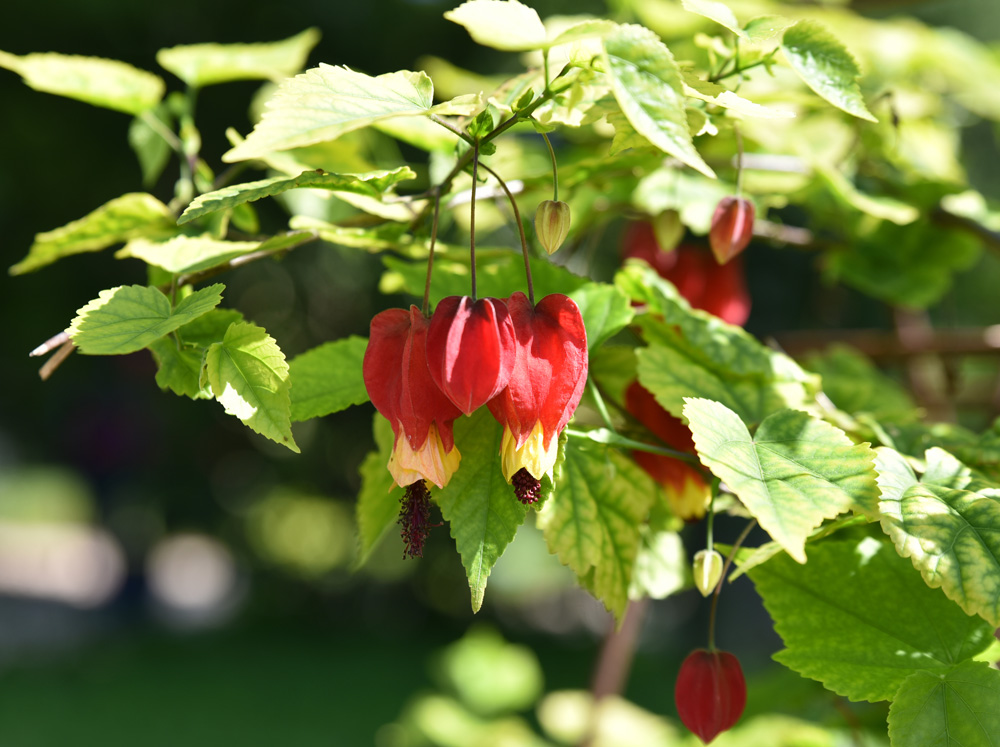
General Information:
Mostly used as an indoor houseplant, the flowering maple is a good alternative for those in climates too hot to grow maples. They are somewhat woody, with two to three inch leaves which are quite similar to maple leaves. So far, rarely used as bonsai, but they are readily available and have 2 inch bell-shaped flowers which bloom year-round to recommend them.
Lighting:
Flowering maples enjoy the sun - give them at least four hours of direct sunlight daily.
Temperature:
A warm weather plant which can be easily grown indoors. It prefers daytime temperatures of 60-72F, but prefers cool nights of 50 55F.
Watering:
Flowering maples like moist conditions as houseplants. Feeding: Once monthly, with indoor plant food.
Pruning and wiring:
Shape is usually maintained through pruning, however wiring should work as long as care was taken to protect the branches.
Propagation:
Through seeds, cuttings in spring. Repotting: These plants do fine in ordinary potting soil.
Pests and diseases:
Spider mites, white flies, aphids.
Some species suitable for bonsai:
Abutilon megapotamicum ‘Variegatum’ - This plant, with its red and yellow blossoms, tends to become a trailing plant as it ages, and is probably only suited to cascade bonsai.
Abutilon pictum - a bushy variety, which has many cultivars grown for their colorful flowers. Two of the most popular are ‘Tangerine Dream’ and ‘Thompsonii’.
Compiled by Sabrina Caine
Acer buergerianum
Common Name:
Trident maple
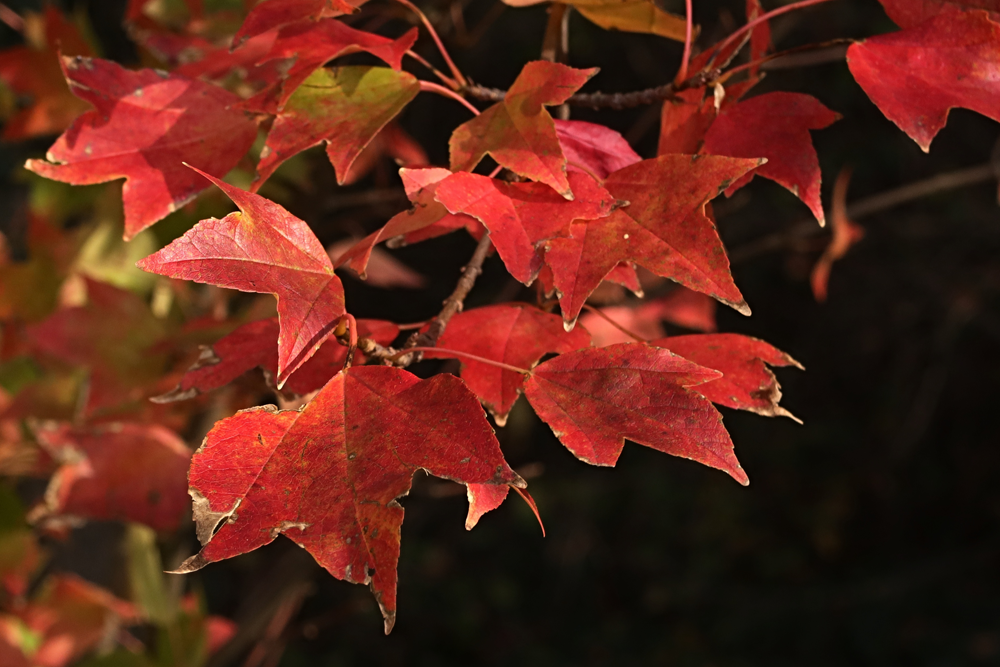
General information:
This deciduous, 30 to 45-foot-high by 25-foot-wide tree in the wild, has beautiful 3-inch-wide, tri-lobed leaves, glossy green above and paler underneath, which turn various shades of red, orange, and yellow in autumn. Flowers are bright yellow and showy in the spring. Trident Maple naturally exhibits low spreading growth and multiple stems but can be trained to a single trunk and pruned to make it branch higher, allowing passage below its broad, oval to rounded canopy. With its moderate growth rate, attractive orange-brown peeling bark, and easy maintenance, Trident Maple is popular as a patio or street tree and is also highly valued as a bonsai subject. Crown form is often variable and selection of a uniformly- shaped, vigorous cultivar is needed. The trident maple is a very popular species for bonsai, due to its small, three-lobed leaves, a readily-thickening trunk, and thick, gnarly roots which adapt well to root-over-rock style.
Family:
Aceraceae
Lighting:
USDA states that this tree will grow in full sun, part sun or part shade. Tomlinson, writing from the UK, believes this maple needs full sun. Simon and Schuster recommends partial shade.
Temperature:
Although hardy in zones 4B through 9, the trident maple’s roots have a high moisture content, and are susceptible to frost damage. This is a potentially fatal problem experienced by members of the Internet Bonsai Club and warned against in almost every book. Tomlinson goes so far as to suggest the substitution of Acer ginnala, the Amur maple, in colder areas. At the very least, this tree should be carefully winter protected.
Watering:
Water moderately in summer, easing off in winter.
Feeding:
Tomlinson, as he usually does, suggests an aggressive feeding schedule: once weekly for the first month after leaves appear, then every two weeks during growth. Simon and Schuster recommends feeding every three weeks during growth, with an interval in midsummer. I’ve used the more conservative schedule with my tree and have been happy with its growth, but find it entirely possible that more frequent feeding would improve the vigor of the tree. More frequent feeding, however, requires increased vigilance in pinching back. If a liquid fertilizer is used, it should not be sprayed on the leaves, as this may result in leaf burn.
Pruning and wiring:
Pinch back new growth to the first two leaves. The tree may be wired at any time during growth, but the branches are somewhat brittle and it is also wise to provide some protection for the bark. The tree, given ample pot space, will grow rapidly, so it is essential to continually check the wire to avoid scarring. Leaf pruning can be carried out in midsummer to miniaturize foliage. Make certain that the tree is healthy and vigorous before leaf pruning. Total leaf pruning should not be carried out annually, as the tree needs a year to restore its stores of energy. I’ve been told that it’s safer to leaf prune gradually, removing only 1/3 to 1/2 of the tree’s largest leaves at a time. The trident’s leaves reduce readily, but it is more difficult to get short internodes and finely ramified branches. For the more advanced/courageous among us, Brent Walston suggests: For smaller pieces, in one gallon training pots, I let them grow wild for 2 or 3 years until the roots completely fill the pot and there is a noticeable decline in vigor. The internodes shorten and the leaves get smaller. It is at this point that I do major pruning shortening them to under a foot. The depleted state of the roots due to the root-bound conditions prevents them from forming the typical coarse growth that usually results following such a pruning. Performing this operation in summer will have an even more dramatic effect, since in essence it is a radical (very radical) defoliation. Root pruning and repotting can take place at the same time. As Michael Persiano would say, these are not procedures for beginners. Once they are potted up and the final branches are selected, several defoliations a season will result in the short internodes and small leaves so desired.
Propagation:
Trident maple can be grown from seed, air-layered, or grown from both hardwood and softwood cuttings. Tomlinson says that even wrist thick cuttings may take, and one instance of a six-inch (!) cutting being rooted successfully has been reported. Best results are achieved taking cuttings in late winter-early spring for hardwood and midsummer for softwood. Seeds require a 24 hour hot water soak, then cold-moist pretreatment for three months. Seeds need to be stored refrigerated, which will start the cold- treatment process. Seeds kept in dry storage are tough to activate, resulting in a poor percentage of germination. If you cannot collect your own seed, it seems that purchasing fresh, properly stored seed from a reputable dealer is essential.
Repotting:
In spring, before buds open. Roots grow very quickly, so annual repotting may be necessary for young trees; older trees tend to need repotting every 2-3 years. If root die-back has occurred during the winter, trim off old root matter to allow room for new growth. Tomlinson recommends a fast-draining soil mix; The USDA states that Trident Maple should be planted in any well-drained, acid soil and is quite tolerant of salt, air pollution, wind and drought. Like other maples, some chlorosis can develop in soils with pH over 7 but it is moderately tolerant of soil salt.
Pests and diseases:
Generally pest and disease free, but are vulnerable to caterpillar attack.
Species/varieties which make excellent bonsai:
Acer b. formosanum, the Taiwan or Formosan Trident.
“Mino Yatsubusa” and “Miyasama Kaede Yatsubusa”, which exhibit various characteristics of being dwarfed.
“Goshika Kaede,” a variegated form.
“Nartua Kaede” and “Tancho”, two with unusual rolled-edged leaves. “Evergreen’s Rough Bark,” valued for its bark appearance.
Bibliography:
Complete Book of Bonsai by Tomlinson The Simon and Schuster Guide to Bonsai USDA Fact Sheet ST-9
Compiled by Sabrina Caine
Edited by Michael Johnson and Thomas L. Zane
Acer campestre
Common Name:
Field maple or Hedge maple
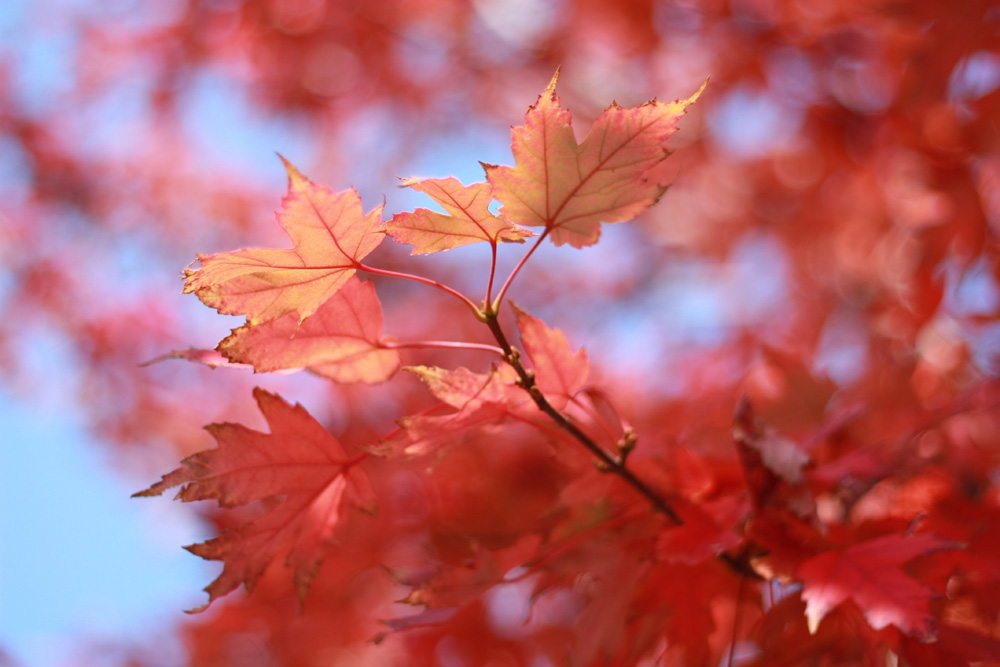
General information:
Simon and Shuster’s guide rates this tree as very easy to cultivate as bonsai. Like the Montpelier maple, the lobes of its leaves are obtuse, otherwise uncommon in maples. Its branches don’t seem to ramify as finely as other maples. It is a pleasing display tree in autumn, with buttercup yellow leaves. In the wild, the tree grows to 30 to 35 ft., but it grows slowly. A dwarf version, “Compactum,” only grows to 6 ft. and is commonly used for hedges. The most desirable cultivar is A. campestre ‘Compacta,’ a dwarf variety with leaves half the size of the species. Hedge Maple is usually low-branched with a rounded form, but there is considerable variability from one tree to the next. The branches are slender and branch profusely, lending a fine texture to the landscape particularly during winter.
Family:
Aceraceae
Lighting:
Unlike most maples, the field maple responds well to direct sunlight.
Temperature:
Hardy in zones 5-8. Small bonsai should be frost protected in winter.
Watering:
Moderate, although if kept in full sun, care must be taken to insure that the soil never dries out completely. Reduce watering in winter, but keep soil evenly moist.
Feeding:
Every two weeks in summer, using a standard bonsai food or half- strength plant food. Time-released pellets are also an option.
Pruning and wiring:
The field maple is easy to style by judicious pruning, as the scars heal quickly and well. It is necessary to prune often to avoid long internodes. Buds back excellently. Wiring should be done on newly hardened branches, as older, thicker branches tend to become stiff. The field maple responds well to a yearly leaf pruning in June, and responds best to wiring if done directly after leaf pruning. With diligent pruning, the leaves can be reduced to below an inch. For medium to large bonsai, this tree can be field grown to reach trunk diameters of two inches or larger.
Propagation:
From seed, after a three month cold treatment, and also from softwood cuttings or air-layering.
Repotting:
The field maple is a fast growing tree, and should be repotted at least every two years. Repot in spring, before bud burst, in basic bonsai soil. Soil tolerances includes: clay; loam; sand; acidic; alkaline; well-drained
Pests and diseases:
Pests:
Leaf stalk borer and petiole-borer cause the same type of injury. Both insects bore into the leaf stalk just below the leaf blade. The leaf stalk shrivels, turns black, and the leaf blade falls off. The leaf drop may appear heavy but serious injury to a healthy tree is rare. Aphids infest maples, usually Norway maple, and may be numerous at times. High populations can cause leaf drop. Another sign of heavy aphid infestation is honey dew on lower leaves and objects beneath the tree. Aphids are controlled by spraying or they may be left alone. If not sprayed, predatory insects will usually bring the aphid population under control. Scales are an occasional problem on maples. Perhaps the most common is cottony maple scale. The insect forms a cottony mass on the lower sides of branches. Scales are controlled with horticultural oil sprays. Scales may also be controlled with other well-timed sprays to kill the crawlers. If borers become a problem it is an indication the tree is not growing well. Controlling borers involves keeping trees healthy. Chemical controls of existing infestations are more difficult. Proper control involves identification of the borer infesting the tree then applying insecticides at the proper time.
Diseases:
Verticillium wilt symptoms are wilting and death of branches. Infected sapwood will be stained a dark or olive green but staining can’t always be found. If staining can not be found do not assume the problem is not verticillium wilt. Severely infected trees probably can’t be saved. Lightly infected trees showing only a few wilted branches may be pulled through. Fertilize and prune lightly infected trees. This treatment will not cure the problem but may allow the tree to outgrow the infection. Girdling roots will cause symptoms which mimic verticillium wilt. Tar spot and a variety of leaf spots cause some concern among homeowners but are rarely serious enough for control.
Bibliography:
The Simon and Schuster Guide “Complete Book of Bonsai,” by Tomlinson “Miniature Bonsai” by Gustafson
“Bonsai” by Resnick
USDA Fact Sheet ST-10
Compiled by Sabrina Caine Edited by Thomas L. Zane
Acer circinatum
Common Name:
Vine maple
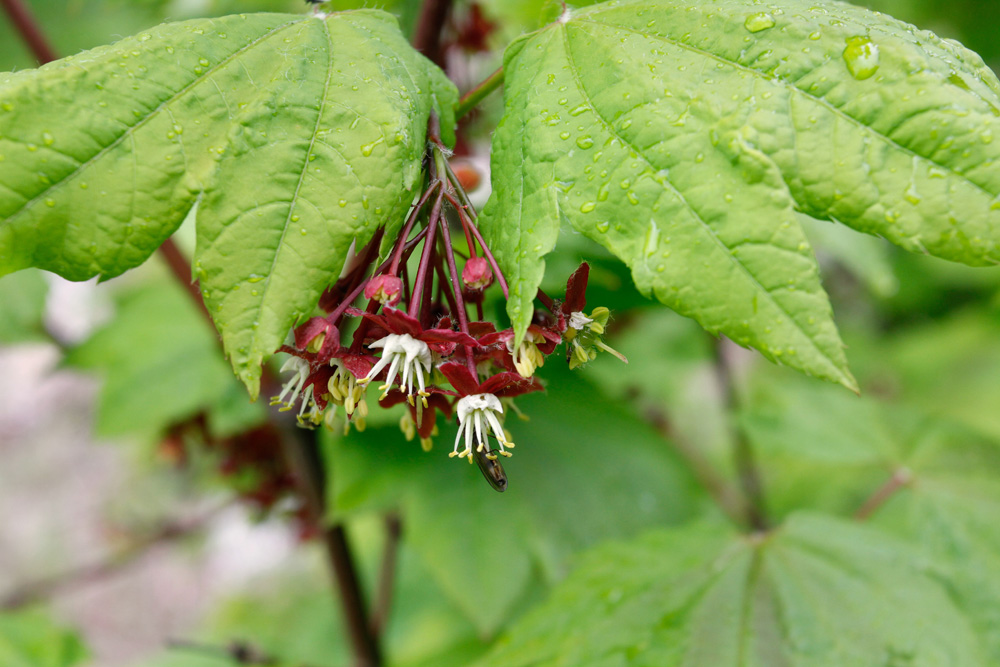
General information:
As bonsai, the vine maple is in its infancy. Like many other species, the vine maple has its pros and cons. Proponents of the vine maple love the shape and autumn color of the leaves. Other advantages of the vine maple are its availability, low cost and longevity. It will bud back readily, and the leaves will reduce to one inch. However, new growth on the vine maple tends to be leggy, which means that constant pruning to avoid long internodes is a must. Difficulty in increasing the trunk diameter of vine maple has also been reported.
Lighting:
In general, maples are subject to leaf burn, and prefer at least partial shade.
Temperature:
Vine maple show less cold hardiness than many other maples. Although vine maple survival at -30F has been reported, it is probably better to stick with the safe recommendation of never below -10.
Watering:
Moderate. Reduce watering in winter, but keep soil evenly moist. Feeding: Every two weeks in summer, using a standard bonsai food or half- strength plant food. Time-released pellets are also an option.
Pruning and wiring:
Pinch back new growth after two pairs of leaves have appeared.
Propagation:
From seed, softwood cuttings or air-layering.
Repotting:
Every 2-3 years. Repot in spring, before bud burst, in bonsai soil slightly rich in organic material.
Bibliography:
Herb Gustafson “Bonsai Workshop,” and “Miniature Bonsai.”
Compiled by Sabrina Caine
Acer davidii, Acer pennsylvanicum
Common Name:
Snakebark Maple
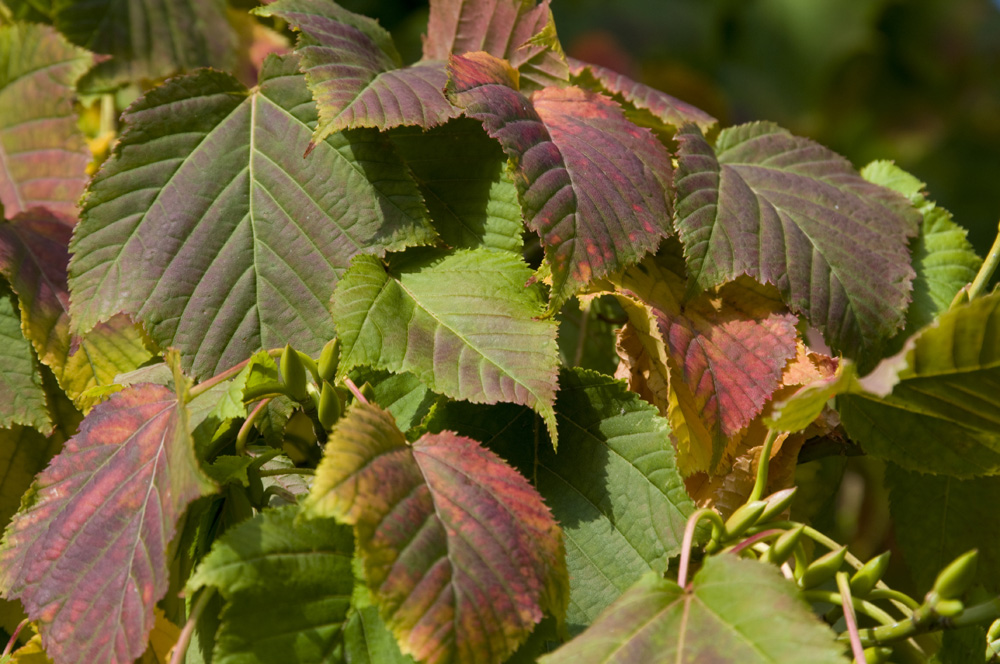
General information:
The snakebark maples are named for their white striped bark which becomes rough and cracked with age. Acer davidii, Pere David’s maple, is a Chinese maple which has seen successful use in bonsai. It is a good tree for high elevations, as it will grow at up to 3000 ft. Acer pennsylvanicum is the only snakebark maple native to the US. It is easily located on the east coast, but rarely found on the other side of the Alleghenies.
Lighting:
Full sun, slight shade in summer. Temperature: No temperature information was available. Watering: Moderate during growth, sparingly in winter. Feeding: Every two weeks in summer.
Pruning and wiring:
Prune as needed during growth. Leaf pruning in midsummer is useful for leaf reduction. Generally used for larger sized bonsai, and does not work well as a broom. Suitable for all other styles.
Propagation:
Cuttings, air-layering, or seeds after cold pre-treatment. Repotting: Every 2-3 years in spring, before bur burst. Use basic bonsai soil. Does not like high pH.
Some species suitable for bonsai:
Acer davidii: snakebark maple, Pere David’s maple - Heart-shaped leaves on red stalks which turn lovely yellow to orange in the fall. A small tree, it grows to about 15m.
Acer davidii ‘Ernest Wison’
Acer davidii ‘George Forrest’ - a fast growing cultivar. Acer pennsylvanicum: striped maple, snakebark maple
Bibliography:
Tomlinson’s “Complete Book of Bonsai”
Species information from Mitchell’s “American Nature Guides: Trees”,
Compiled by Sabrina Caine
Acer ginnala
Common Name
Amur maple
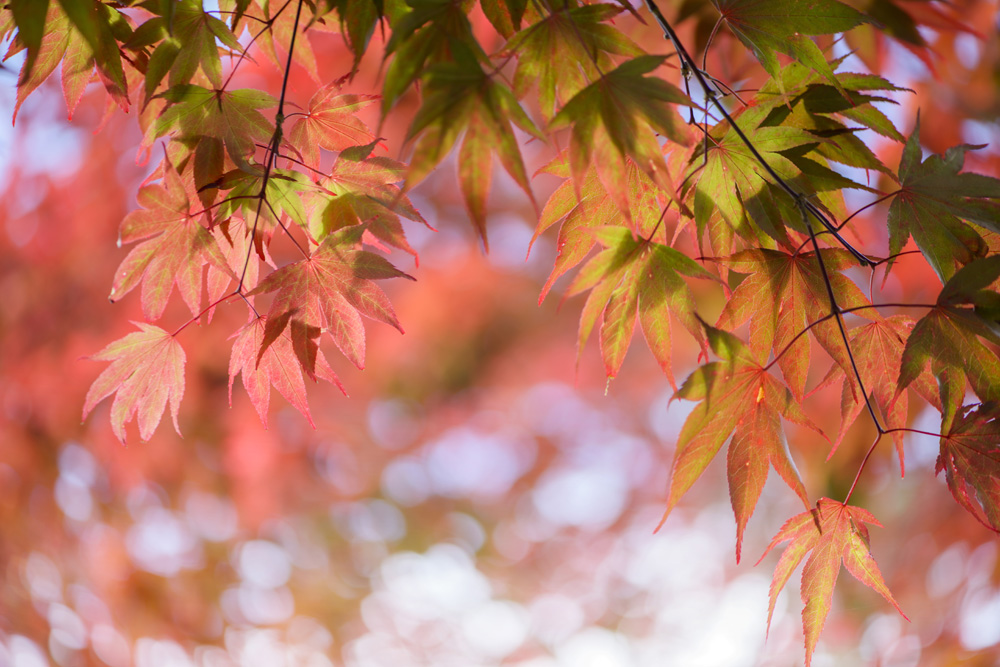
General information:
Amur maple is an excellent, low-growing tree for small yards and other small-scale landscapes. It can be grown as a multi- stemmed clump or can be trained into a small tree with a single trunk up to four to six feet tall. The tree grows about 20 to 30 feet tall and has an upright, rounded, finely branched growth habit which creates dense shade under the crown. Due to excessive branchiness, some pruning is required early in the life of the tree to create dominant major branches. Amur maple can grow rapidly when it is young if it receives water and fertilizer, but it is well-suited for planting close to power lines since it slows down and remains small at maturity.
Amur maple has only started to attain popularity as a bonsai. It is certain to become widely used as it is an attractive, fuss-free maple. It shares the three-lobed leaves of trident maple, but is much more frost resistant. In fact, it is more tolerant of adverse conditions than most other maples. Amur maple also has its brilliant autumn coloration to recommend it. ‘Durand’s Dwarf’ is an especially desirable cultivar for bonsai.
Family:
Aceraceae
Lighting:
Full sun, part sun, but part shade in midsummer and in very hot climates to prevent leaf burn.
Temperature:
Very weather resistant - thrives in zones 3 to 8, but may be grown in somewhat hotter areas if care is taken to prevent leaf-burn or dehydration.
Watering:
Moderate - increase watering during the summer heat, and keep fairly dry in winter.
Feeding:
Weekly for the first month after leafing out, then every two weeks through summer. Use bonsai fertilizer or half strength plant food.
Pruning and wiring:
Acer ginnala takes well to bonsai techniques. It buds back rapidly on old wood, and thus can be cut back quite hard. Its leaves will reduce to under one inch if it is defoliated once every two years in midsummer. New shoots should be pruned through the growing season. Acer ginnala may be wired, but like other maples, may require some protection of the bark.
Propagation:
Cuttings, seed, air-layering.
Repotting:
Soil tolerances include clay, loam, sand, acidic, alkaline, well- drained. Repot in early spring, before bud burst, using a fast-draining soil mix. Young trees may need to be repotted annually. Otherwise, repot every two years, but not in the same year that the tree is defoliated.
Pests and diseases:
Pests:
Amur maple is usually pest-free. Aphids infest maples, usually Norway Maple, and may be numerous at times. High populations can cause leaf drop. Another sign of heavy aphid infestation is honey dew on lower leaves and objects beneath the tree. Aphids are controlled by spraying or they may be left alone. If not sprayed, predatory insects will bring the aphid population under control. Scales are an occasional problem on maples. Perhaps the most common is cottony maple scale. The insect forms a cottony mass on the lower sides of branches. Scales are usually controlled with horticultural oil sprays applied in spring before growth begins. Scales may also be controlled with well-timed sprays to kill the crawlers. If borers become a problem it is an indication the tree is not growing well. Controlling borers involves keeping trees healthy. Chemical controls of existing infestations are more difficult. Proper control involves identification of the borer infesting the tree then applying insecticides at the proper time.
Diseases:
Verticillium wilt symptoms are wilting and death of branches. Infected sapwood will be stained a dark or olive green but staining can’t always be found. If staining can not be found do not assume the problem is not verticillium wilt. Severely infected trees probably can’t be saved. Lightly infected trees showing only a few wilted branches may be pulled through. Fertilize and prune lightly infected trees. This treatment will not cure the problem but may allow the tree to outgrow the infection. Girdling roots will cause symptoms which mimic verticillium wilt. Scorch occurs during periods of high temperatures accompanied by wind. Trees with diseased or inadequate root systems will also show scorching. When trees do not get enough water they scorch. Scorch symptoms are light brown or tan dead areas between leaf veins. The symptoms are on all parts of the tree or only on the side exposed to sun and wind. Scorching due to dry soil may be overcome by watering. If scorching is due to an inadequate or diseased root system, watering may have no effect.
Bibliography:
“Bonsai” by Resnick
“Complete Book of Bonsai” by Tomlinson
“The Hearst Garden Guide to Trees and Shrubs” edited by Thomas USDA Fact Sheet ST-14
Compiled by Sabrina Caine Edited by Thomas L. Zane
Acer monspessulanum
Common Name: Montpelier maple
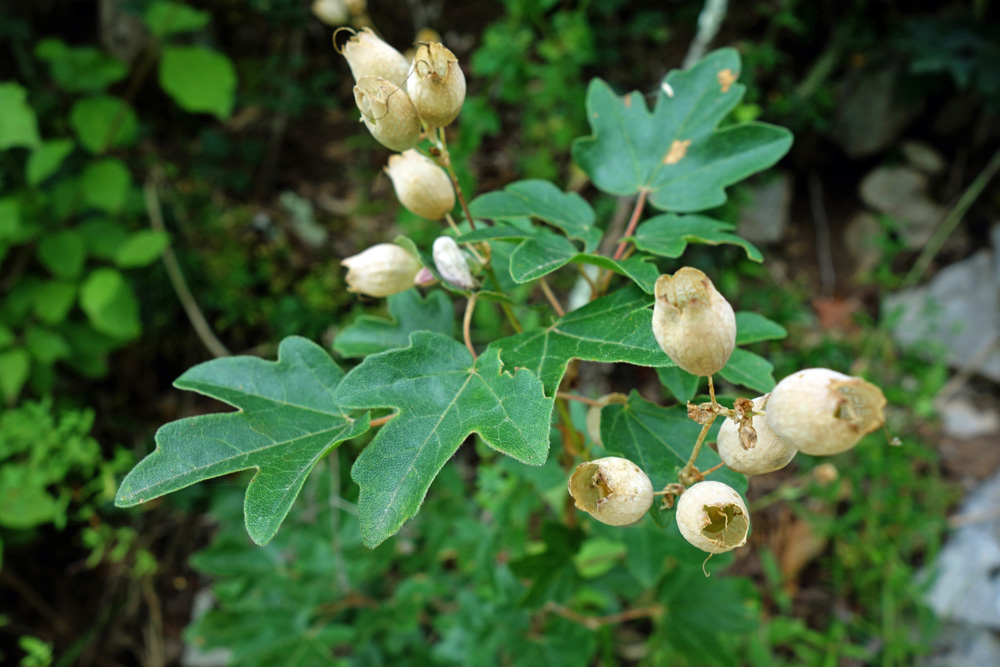
General information:
Native to southern Europe and Northwest Africa, the Montpelier maple is not yet used widely in the U.S. for bonsai. It has much potential, however, because of its three-lobed, obtuse leaves which are naturally small, and easily reduced even further. It can also withstand climates too hot or dry for most maples. Its major drawback is that it lacks the spreading growth of most maples, forming instead a narrow pyramid. With patience, the tree can be developed into a fuller shape, but I kind of like this maple’s gingkoesque looks!
Lighting:
Unlike most maple species, the Montpelier maple enjoys full sun. Partial shade is recommended in hot climates or during midsummer.
Temperature:
It seems to be hardy to at least zone five.
Watering:
The Montpelier maple can withstand dry conditions better than other maples.
Feeding:
Every three weeks from early spring to late autumn, pausing for a month in midsummer, using a bonsai fertilizer or general purpose plant food at half strength.
Pruning and wiring:
Pinch back new growth after two pairs of leaves have appeared. Wire from spring to autumn. Care must be taken when wiring to protect the bark. Exposing the Montpelier maple to sun and dry conditions will allow leaf reduction to occur more quickly than is seen in most other maples.
Propagation:
From seed or cuttings.
Repotting:
Every 2-3 years. Repot in spring, before bud burst, in bonsai soil slightly rich in organic material.
Information Sources:
Information on the Montpelier maple is taken from the Simon and Schuster Guide.
Compiled by Sabrina Caine
Acer palmatum
Common Name:
Japanese Maple
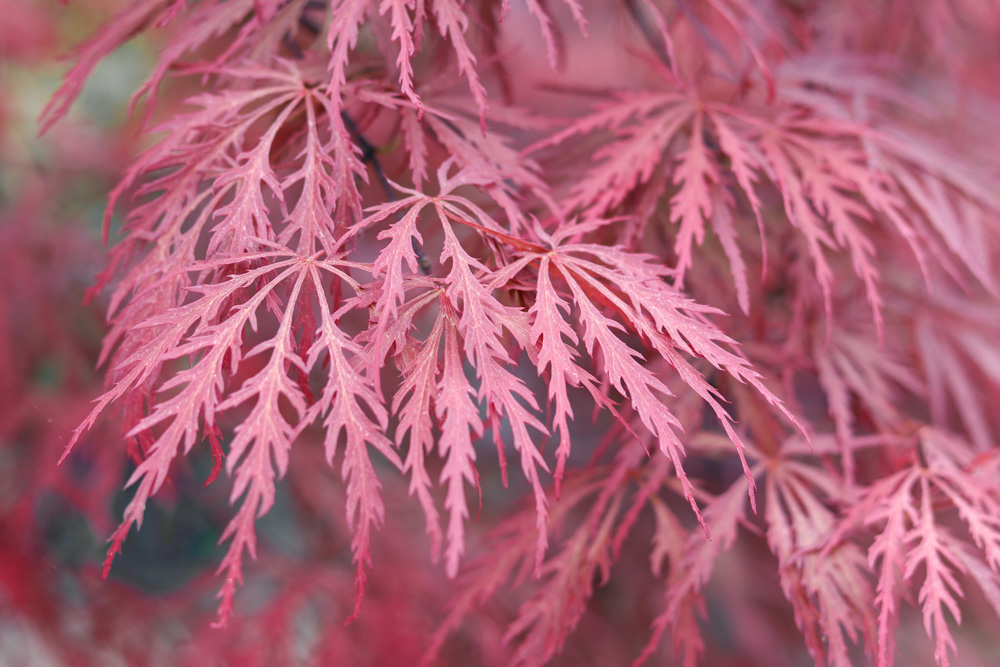
General Information:
This maple is native to China and Japan. Its botanical name comes from its leaves, which have 5 or more deep lobes and vaguely resemble a human hand. It is a popular bonsai subject in Japan. The bark on young branches and trunks is usually green (may be red on some varieties) and turns brown or light gray with age. There are many different varieties of A. palmatum, including thread-leaf or lace-leaf varieties and both green and red varieties. The red varieties seem to be more popular as bonsai.
Lighting:
Place the tree where it will receive morning or evening sun but will not be in direct sunlight at the height of summer, and do not water in direct sun. The delicate foliage can “burn” if exposed to direct summer sun. Water well in early morning or late afternoon to prevent the soil from drying out.
A credible dissenting opinion says that maples do not burn because of exposure to the sun per se, but rather due to the presence of dissolved minerals in the water supply. These minerals build up in the leaves, making them more susceptible to browning and curling when exposed to strong sunlight. The traditional opinion has been that the burning effect happens because of water droplets acting like a lens to concentrate the sunlight. Anecdotal evidence can be found to support either point of view.
Temperature:
Watering:
Daily watering but with good drainage to prevent root rotting.
Feeding:
Simon and Schuster’s recommends feeding every 20-30 days with a slow-acting organic fertilizer from spring to autumn. Do not feed for two months after repotting or when a tree is weakened. Stop feeding for a month or two during the hottest part of the summer. If you prefer to use chemical fertilizers, feed every other week with a half-strength solution of a balanced fertilizer, such as Peter’s 20-20-20.
Pruning and wiring:
Root pruning should be accompanied by branch pruning so that the root system is not overstressed trying to supply nutrients to an oversize branch system. Branch pruning should be done mainly in fall or winter, to avoid excess loss of sap and so that the shape of the tree can be better seen. Seal pruning wounds with a wound dressing (bonsai suppliers often carry a wound dressing putty from Japan that works well and can be cleaned up after the wound has healed).
To develop fine branches and avoid long internodes, pinch back new growth during the growing season. Pinch back new shoots by pruning them to two sets of leaves (internodes). An internode is the space on a branch from one pair of leaves to the next. In Japan, the centres of new shoots are removed with tweezers and a magnifying glass just as the shoot is opening up for maximum internode reduction.
If a branch has already been allowed to grow out with long internodes, the only way to shorten them is to cut back the branch to the first internode and re-grow it, with appropriate pinching to keep the internodes short.
Leaf pruning (removal of leaves during the growing season) can be done every other year in early summer to encourage smaller leaves. All of the leaves are removed from the tree, leaving the leaf stems on the branches. This “false autumn” results in a second set of leaves that is smaller than the first set. Do not leaf prune the same year that a tree is repotted.
Maples are usually shaped by pinching and pruning. If wiring is necessary, wire in summer when the tree is in full leaf, protect the bark with raffia, and do not leave the wire on for more than six months. The trunk of a young maple can be shaped by tying it to a stake so that it is bent in the desired shape or kept straight if a formal upright is desired.
Propagation:
Cutting, layering.
Repotting:
Repot every two or three years for older trees, at least every other year for young trees. Repot in spring, shortening the roots by up to half their length. The roots may be washed in water to make repotting easier. Any dead or damaged roots should be removed to avoid root rot. Simon and Schuster’s recommends 60% soil, 20% peat, and 20% coarse sand. Rémy Samson recommends 2 parts loam and 1 part coarse sand. Peter Chan recommends 1 part loam, 1 part peat, and 1 part coarse sand. Plant in a shallow pot to allow the roots to spread out and soak up warmth from the sun. Unglazed oval pots in earth tones are usually used.
Pests and diseases:
Aphids, mildew, root rot.
Compiled by Sabrina Caine
Acer rubrum
Common Name
American Red Maple
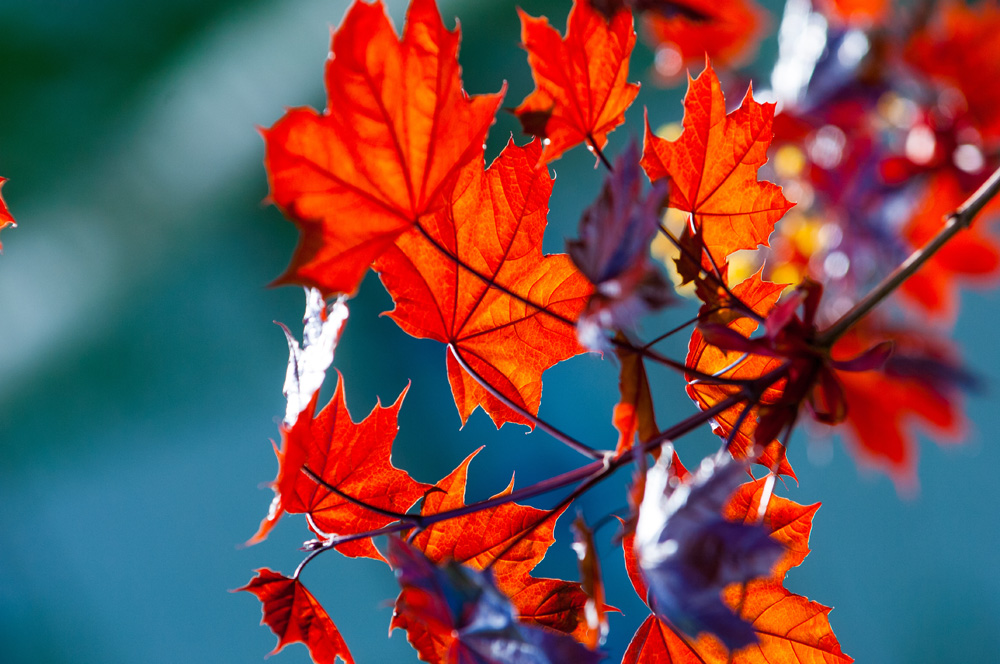
General Information:
Also called Swamp Maple, A. rubrum in nature is a tree, 60 to 75 feet tall. Young trees are often pyramidal or elliptical and are fast growers with strong wood. Older trees develop ascending branches, resulting in an ovoid or rounded crown. A common tree of mixed hardwood and floodplain forests. It is best to select trees for a specific area that have been grown from seed collected there. There is ample evidence to suggest that trees native to a specific area are more likely to be hardy there. Tolerates ozone and is somewhat tolerant of sulfur dioxide, making it a good tree for urban areas. Leaves are opposite, 2 to 4 inches, quite variable in shape, 3-5 lobes, dullish green, with (usually) reddish leafstalk. They turn brilliant red, orange and yellow in fall. In N. Florida there is a variety with consistently 1.5 inch leaves that is mostly 3-lobed (possibly trilobum variant) and has a generally dull yellow leaf colour in fall. The leaves appear in late spring, as the maple seeds mature. Small, showy red flowers begin to bloom in late winter or early spring (second week in February in northern Florida) and bloom through March. Fruits and seeds are winged and often, but not always, red. They occur in great profusion in late spring and early summer.
Family:
Aceraceae
Lighting:
Full sun to part shade.
Temperature:
Hardy to zones 4-9.
Watering:
A. rubrum prefers wet to moist soils. Stream and pond banks, mesic forests, swamps and (sometimes) drier uplands. Water copiously during the warm months, especially if the soil does not hold water. In hot climates (and especially in the arid west) keeping the tree in a shallow tray of water may be necessary.
Feeding:
Fertilize weekly, beginning in early spring; bi-weekly in fall until leaves begin to turn. Use a well-balanced fertilizer (10-10-10).
Pruning and wiring:
A. rubrum can be styled as informal upright, slanting, clump, group and forest. I have never grown A. rubrum as a cascade or root-over-rock, since neither represents its “natural” growing habitat. The bark of A. rubrum (as other maples) is tender and scars easily. On the rare occasion that I do wire, I use unstripped aluminum wire. Since the natural growth habit of A. rubrum is to have ascending branches, forming a generally oval shape with a rounded top, wiring to pull down branches is not necessary. Wires must be watched carefully. Even rubber-coated aluminum wire will scar before a summer has passed. Pruning is the primary means of shaping A. rubrum. Pruning and leaf trimming can be used to increase the ramification of twigs, to induce branches to grow where none grow now, and to create valuable open spaces. Trim new growth by allowing one or two nodes to grow, then pinching back to one. The more frequent and more severe the pinching back, the shorter the distance between the leaves and new branch nodes. Major pruning should (as always) be undertaken with care. A branch, once removed, is difficult to replace. Although you might be able to induce sprouting at the site of the scar, the resulting branch will be thin and awkward looking. In the case of major branch removal, A. rubrum will repair pruning scars quite well if the cut is made flush with the trunk. I seldom use anything to seal the cuts. A. rubrum will endure leaf stripping (complete removal of leaves), but leave the leaf stem attached (it will fall off when new leaves appear). You also may cut leaves in half. I have seen no benefit from partial leaf stripping (stripping leaves from selected areas of the tree in an attempt to develop better twig and branch structure).
Propagation:
Seed - 25-60% germination, according to “authorities.” Based on the seedlings that appear in my yard each summer, 60% is the rule. They also propagate easily from cuttings. I have never tried to air layer one. Most of mine are from seedlings transplanted from the “wild” (underfoot).
Repotting:
Small specimens may be bare rooted for transplant. Larger specimens must be balled and bur lapped in order to be moved. Potting and root pruning should be done in spring, as leaf buds turn a brighter red. This tree, when mature, is quite hardy and will suffer severe root pruning to no disadvantage that I can see. (However, I would not strip leaves in the same year as the severe root pruning.) Since this is a tree of usually wet to damp soils, the tap root is not well developed. Root pruning probably should be done every other year on a mature maple, but the amount of annual root growth will vary, depending on conditions, the pot, fertilization schedule, watering regime, and the individual tree. Younger trees and seedlings-in- training may be root pruned annually. Being a wetland tree by preference, the red maple will survive in (and may even prefer) a heavier, more water-retaining soil than other trees (or other maples). I use a similar organic compost mix (no gravel) for A. rubrum as for T. distichum. They will, however, do quite well in a “normal” bonsai soil -- although in hot climates they may as a result require more frequent watering than other trees, or may need to be placed in a shallow tray of water. Normally, I do not keep red maples in water except during the hottest (above 95 degrees F) part of the summer. A. rubrum tolerates many different soils, but prefers slightly acidic, moist soil. Highly acidic soils cause chlorosis due to high levels of manganese.
Maples in general seem to want more root underneath them than some other deciduous trees. A. rubrum is no exception. Peter Adams in The Art of Bonsai notes that maples “must have root run,” which I interpret to mean a slightly larger-than-normal (i.e. deeper) pot for a tree of a given height or girth. Dark, unglazed earth-tone pots are acceptable, but I prefer a white- or blue glazed pot. Shape--oval or rectangle, depending on the styling of the tree. Here, though, your own tastes are paramount.
Pests and diseases:
Pests:
Leaf stalk borer and petiole-borer cause the same type of injury. Both insects bore into the leaf stalk just below the leaf blade. The leaf stalk shrivels, turns black, and the leaf blade falls off. The leaf drop may appear heavy but serious injury to a healthy tree is rare. Gall mites stimulate the formation of growths or galls on the leaves. The galls are small but can be so numerous that individual leaves curl up. The most common gall is bladder gall mite found on silver maple. The galls are round and at first green but later turn red, then black, then dry up. Galls of other shapes are seen less frequently on other types of maples. Galls are not serious, so chemical controls are not needed. Crimson erineum mite is usually found on silver maple and causes the formation of red fuzzy patches on the lower leaf surfaces. The problem is not serious so control measures are not suggested. Aphids infest maples, usually Norway Maple, and may be numerous at times. High populations can cause leaf drop. Another sign of heavy aphid infestation is honey dew on lower leaves and objects beneath the tree. Aphids are controlled by spraying or they may be left alone. If not sprayed, predatory insects will bring the aphid population under control. Scales are an occasional problem on maples. Perhaps the most common is cottony maple scale. The insect forms a cottony mass on the lower sides of branches. Scales are usually controlled with horticultural oil sprays. Scales may also be controlled with well-timed sprays to kill the crawlers. If borers become a problem it is an indication the tree is not growing well. Controlling borers involves keeping trees healthy. Chemical controls of existing infestations are more difficult. Proper control involves identification of the borer infesting the tree then applying insecticides at the proper time. Twig borers can cause die-back of the terminal 8 to 12 inches of small-diameter branches. This is usually not serious and does not require control measures, but it can be a problem on young trees in the nursery.
Diseases:
Anthracnose is more of a problem in rainy seasons. The disease resembles, and may be confused with, a physiological problem called scorch. The disease causes light brown or tan areas on the leaves. Anthracnose may be controlled by fungicides sprayed on as leaves open in the spring. Two additional sprays at two-week intervals will be needed. The disease is most common on sugar and silver maples and box elder. Other maples may not be affected as severely. Sprays may need to be applied by a commercial applicator having proper spray equipment. Girdling roots grow around the base of the trunk rather than growing away from it. As both root and trunk increase in size, the root chokes the trunk. Girdling roots are detected by examining the base of the trunk. The lack of trunk flare at ground level is a symptom. The portion of the trunk above a girdling root does not grow as rapidly as the rest so may be slightly depressed. The offending root may be on the surface or may be just below the sod. The tree crown shows premature fall coloration and death of parts of the tree in more serious cases. If large portions of the tree have died it may not be worth saving. Girdling roots are functional roots so when removed a portion of the tree may die. When the girdling root is large the treatment is as harmful as the problem. After root removal, follow-up treatment includes watering during dry weather. The best treatment for girdling roots is prevention by removing or cutting circling roots at planting or as soon as they are detected on young trees. Scorch may occur during periods of high temperatures accompanied by wind. Trees with diseased or inadequate root systems will also show scorching. When trees do not get enough water they scorch. Scorch symptoms are light brown or tan dead areas between leaf veins. The Page 3 American Red Maple symptoms are on all parts of the tree or only on the side exposed to sun and wind. Scorching due to dry soil may be overcome by watering. If scorching is due to an inadequate or diseased root system, watering may have no effect.
Bibliography:
Stowell’s The Beginner’s Guide to American Bonsai
Petrides’ A Field Guide to Trees and Shrubs for a typical silhouette of the red maple.
USDA Fact Sheet ST-41
Compiled by Jim Lewis
Edited by Michael Johnson and Thomas L. Zane
Albizia sp.
Common Name:
Mimosa (Silk tree)
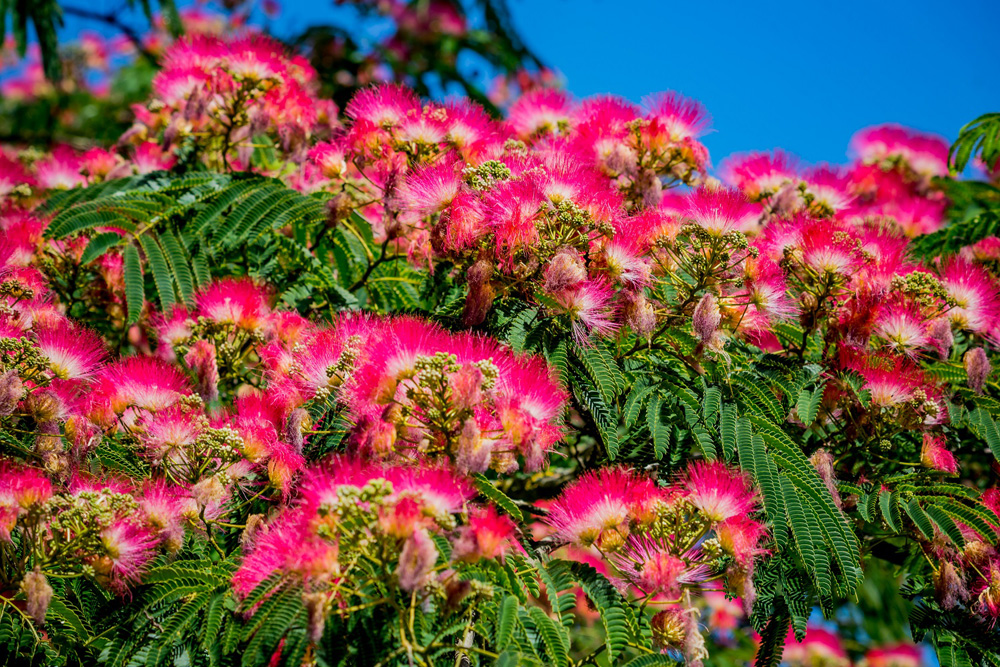
General Information:
Albizia are called silk trees because of the exotic pink flowers which have delicate silky filaments. Because of this, the tree makes an interesting, if problematic bonsai. The tree is fast growing, deciduous, but short lived (10 - 20 years) and the leaves are huge, making it suitable for only large size or unconventional bonsai. In addition, when the flowers get wet, they turn into a gooey mess. The tree is called “mimosa” in the south, but should not be confused with the similar trees, Acacia baileyana and dealbata, which are called “mimosa” in Texas.
The tree has a low branching, open, spreading habit and delicate, lacy, almost fern-like foliage. Fragrant, silky, pink puffy pompom blooms, two inches in diameter, appear in abundance from late April to early July creating a spectacular sight. But the tree produces numerous seed pods and harbors insect (webworm) and disease (vascular wilt) problems.
Family:
Leguminosae
Temperature:
It loves heat. Hardy in zones 6B - 9. Needs winter protection in the colder areas of its range to prevent die back.
Lighting:
Full sun.
Watering:
Moderate to slightly dry. Do not ever get the flowers wet! Feeding: No information available.
Pruning and wiring:
Suitable for only large size or non-traditional bonsai, due to the large compound leaves. In nature, they often grow with multiple trunks, and thus may suggest this style in bonsai. Prune in winter or early spring as needed. Wire branches when relatively young, as the branches become quite brittle when old.
Propagation:
By seed. Soaking and scarification may be necessary, as with most legumes.
Repotting:
Grows best in well-drained soil, although tolerant of poor and alkaline soil. Repot in spring.
Pests and diseases:
Problems include cottony cushion scale, mites, Mimosa webworm.
Diseases Mimosa (Fusarium) wilt is quite a problem and is fatal. It can spread to adjacent Mimosa trees by root grafts.
Some species suitable for bonsai:
Albizia julibrissin: silk tree, mimosa - this tree grows to 40 feet, and has greenish-gray striped bark. Its compound leaves are huge - 12-18 inches. Although it is known as a hot weather tree, it actually grows as far north as Long Island.
Albizia julibrissin ‘Rosea’: A smaller variety, which grows only to 20 ft. and has smaller flowers; it may therefore be more suitable for bonsai.
Bibliography:
USDA Fact Sheet ST-68
Compiled by members of the Internet Bonsai Club. Edited by Thomas L. Zane
Amelanchier sp.
Common Name:
Serviceberry
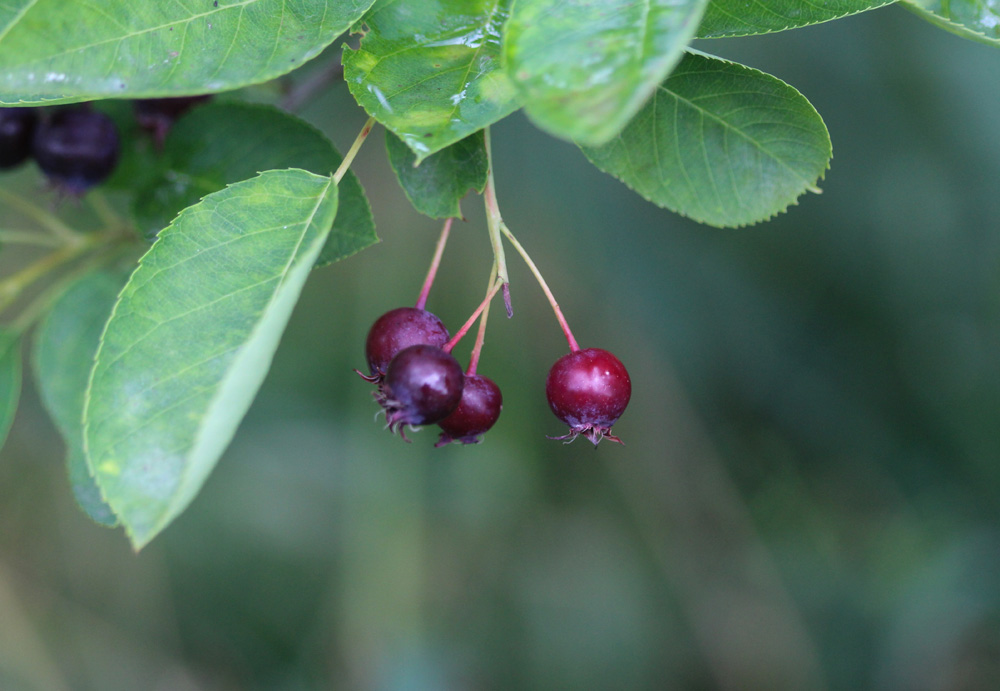
General information:
This native large shrub or small tree has a moderate growth rate in most soils. Multiple stems are upright and highly branched forming a dense shrub with many small-diameter branches or, if properly pruned, a small tree. Trees can be trained to, and are offered by nurseries, with one trunk. The main ornamental features are white flowers followed by purple fruit in late spring or early summer. Fruits are produced before the leaves in spring and are quickly eaten by birds. Serviceberry puts on a brilliant fall color display ranging from yellow and orange to dull red. This tree is suitable for naturalistic plantings and will attract birds. The tree suckers from the base of the trunk, which can be a maintenance problem in urban plantings or in formal landscapes.
It is know variously as serviceberry, sarviceberry, sarvistree, shadbush, Juneberry, Mespilus, grape pear, swamp sugar pear, bloody choke-berry and Saskatoon berry. The name Amelanchier is said to derive from the honey-tasting berries. These berries are actually quite good in preserves etc., but are rarely used because they are so quickly eaten by birds. The names containing “shad” apparently refers to the flowering time of the plant, which happens when the shad fish are running. The wood, called Meesassquat-ahtic, was prized by the Cree for making arrows. As bonsai, however, the Amelanchier is still in its infancy. One species, A. asiatica, the Japanese Juneberry, is used somewhat in Japan. The other species listed are experimental; the most success has come from using A. alnifolia and A. lamarckii.
Family:
Rosaceae
Lighting:
Part shade, part sun, full sun.
Temperature:
A temperate tree, some Amelanchier varieties can take up to Zone 3, but most dislike it warmer than Zone 8.
Watering:
Moderate.
Feeding:
Every two weeks, spring through autumn, using liquid bonsai fertilizer or half-strength plant food.
Pruning and wiring:
Likes to sucker from the roots, so if a large trunk is desired, this tendency must be checked by constant pruning. Styling Amelanchier as a clump can put this characteristic to positive use.
Propagation:
Seeds, softwood cuttings, grafting, air-layering.
Repotting:
Every second year in early spring, using basic soil mix. Amelanchier likes to put down long taproots, so it may take a few years in gradually smaller training pots to establish it as bonsai.
Pests and diseases:
Pests:
Cambium miners cause concern when noticed but are not very damaging to the tree. The mines can extend from a twig all the way down to the roots. The mines form light-colored lines in the bark. No controls are usually suggested. A leaf miner will mine leaves, particularly the lower half of the leaf. The mines are irregular in shape. The leaves of amelanchier are skeletonized by at least two insects. The first insect forms small cocoons on the undersides of leaves. Skeletonized leaves look as though they have windows in them after the insects scrape tissue off the top and bottom of the leaves. The second insect is the larva of the pear sawfly. The larvae are black to greenish black and look slimy. Adult sawflies lay eggs in early and late summer. Heavily skeletonized leaves drop off. Several borers attack amelanchier. Healthy trees are considered less susceptible so regular fertilization and watering during dry spells will help prevent borer attacks. Spider mites will feed on amelanchier. These insects are hard to detect as they are so small. The main symptom of mite injury is the loss of green leaf coloration. If the infestation is heavy, very fine webbing may be seen. Horticultural oil sprays help control mite infestations. Aphids of several types suck juices from amelanchier. Heavy infestations cause distortion of the foliage and new growth, and deposit large amounts of sticky honeydew on lower foliage. Black sooty mold will grow on the honeydew.
Diseases:
Witches broom, also called black mildew, infects the growing point causing the formation of many stems. The cluster of stems is called the witches broom. Another symptom is a black fungal growth, coating the undersides of the leaves. The damage to the tree is usually not serious and the brooms can be pruned off. No chemical controls are suggested. Leaf blight can cause leaf drop when a severe infection occurs. The disease causes small purple spots on the leaves. The spots enlarge and turn brown, later a small black dot will be seen in the center of the spot. Large numbers of spots cause infected leaves to drop. Fire blight is characterized by the sudden wilting and death of branch tips. The blossoms wilt, blacken and hang on the twig. The bark is shriveled and has small bumps or blisters on it. Sometimes gum oozes out of the infected area and a crack forms between the diseased and healthy bark. Control with chemicals is difficult. Diseased branches should be pruned out. Make the cut at least four inches beyond the diseased area. Disinfect pruning tools with bleach between cuts. Fertilizing heavily with nitrogen increases susceptibility to fire blight. Powdery mildews of several types cause white powdery growth on the leaves of amelanchier. Late in the season no controls may be needed. Fruit rot be a problem in wet weather. The fruits are often eaten by birds so may not be around long enough to become diseased. Cedar rusts can be troublesome.
Some species suitable for bonsai:
Amelanchier alnifolia: Western serviceberry, coarsely toothed rounded leaves, clusters of white flowers, apple-shaped fruits. Normally forms shrubby thickets. Zones 4-9.
Amelanchier arborea (also called A. canadensis): shadbush, downy serviceberry, sarvistree, juneberry, sarviceberry - smooth, light brown bark, profuse white flowers, and purple- red fruit that is loved by birds. It has a nice autumn display of orange and yellow leaves. Hardy in Zones 3-8. It seems to dislike pot culture immensely.
Amelanchier asiatica: Japanese juneberry - quite possibly the most popular Amalanchier species for bonsai.
Amelanchier x grandiflora: apple serviceberry - a hybrid between A. arborea and A. laevis, with larger flowers.
Amelanchier laevis: Allegheny serviceberry - Very similar to A. arborea, but new leaves are tinged purple.
Amelanchier lamarckii: snowy mespilus - Scented white flowers in mid-spring, followed by purple fruit in autumn.
Amelanchier stolonifera: running serviceberry Bibliography: USDA Fact Sheet ST-73
Compiled by Sabrina Caine
Ampelopsis brevipedunculata
Common Name:
Porcelain Berry
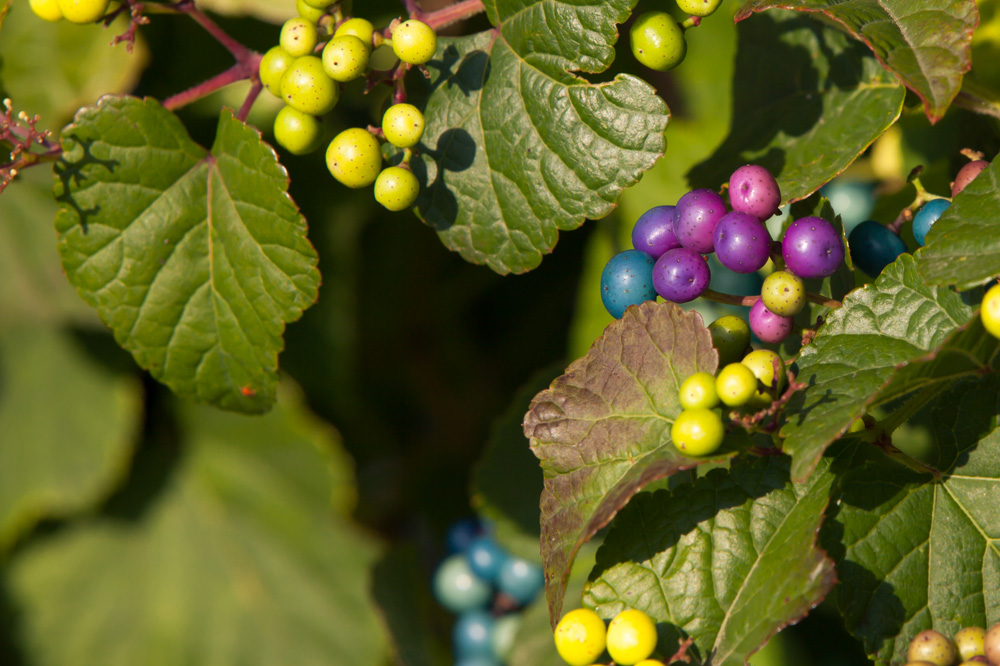
General Information:
Once classified as Hedera, an ivy, and then as Vitis, a vine, the genus Ampelopsis was created in 1803. Nobody cared. In 1887, botanists finally took note when the genus was further divided into Ampelopsis and Parthenocissus over some small variations in structure. The end result is that there are few common plants that fall into this genus, and we have two almost unspellable names to remember.
The choice for bonsai is Ampelopsis brevipedunculata, the wild grape or porcelain berry, although the Samsons recommend the genus in general. A. brevipedunculata is a lovely creeping plant with porcelain blue berries.
Lighting:
Likes lots of light, especially the variegated forms.
Temperature:
Can be grown as an indoor bonsai. The Samsons recommend that it never be exposed to temperatures under 54F. However, the company that sold me my Ampelopsis brevipedunculata claims that it should be hardy in zones 6-9, and those who posted indicated that their porcelain berries survived temperatures of 20F and below. Ampelopsis should have a dormant period with leaf loss.
Watering:
Variable according to the growth of the plant. In winter, will need little water, but in summer, it will drink, drink drink!
Feeding:
The Samsons recommend slow-acting organic fertilizer in spring and autumn. I’ve been using Pokon Bonsai Food once monthly, and it seems just fine. Heavy phosphorus feeding in autumn may help to prevent winter die back.
Pruning and wiring:
In a relatively short time, Ampelopsis will form a gnarled, woody trunk. It is very fast growing, and a natural creeper. Styling it as anything other than weeping or cascade styles would be a challenge, to say the least! It is easiest to develop a thick trunk and a few nice branches, and then allow new growth to extend each season. (It may be necessary to prune die back, in any case) To keep the tree neatly styled, wait until 3-5 “eyes” have developed, then prune to 1-2 “eyes” as necessary throughout the growing season. It can be wired during the spring and summer, but wiring should be used sparingly and limited to trunk and major branches. Ampelopsis can be leaf-pruned in late spring or early summer to promote leaf reduction. The plant may flower several times during the season. Murata recommends that fruit from early flowers be removed, as it tends to have an unattractive dirty white colour, and dead-heading will promote the appearance of later flowers. Flowers from late in the season produce the characteristically lovely blue berries.
Propagation:
From softwood cuttings in early spring, or by simple layering in April-May. The plant may also be grown from seeds collected from the berries, which must be cold treated and sown in spring.
Repotting:
Every second year in April. Depending on rate of growth, roots may be pruned by up to half. Use basic soil mix, perhaps a bit heavy on the organic components.
Pests and diseases:
Scale, mildew, black rot. The leaves are very susceptible to insect damage; unfortunately, the leaves are also quite sensitive to pesticide when sprayed. A systemic applied early in the season may be the best solution. Trailing branches often die back in the winter.
Some species suitable for bonsai:
Ampelopsis brevipedunculata - porcelain berry.
Ampelopsis brevipedunculata ‘Elegans’ - a stunning variety. Magenta stems contrast with green and cream colored leaves and porcelain blue berries. Zones 6-9.
Bibliography:
Murata’s “Four Seasons of Bonsai”
Samsons’ “Creative Art of Bonsai”
Species information from Coats’ “Garden Shrubs and Their Histories.”
Compiled by Sabrina Caine
Betula nigra
Common Name:
River birch
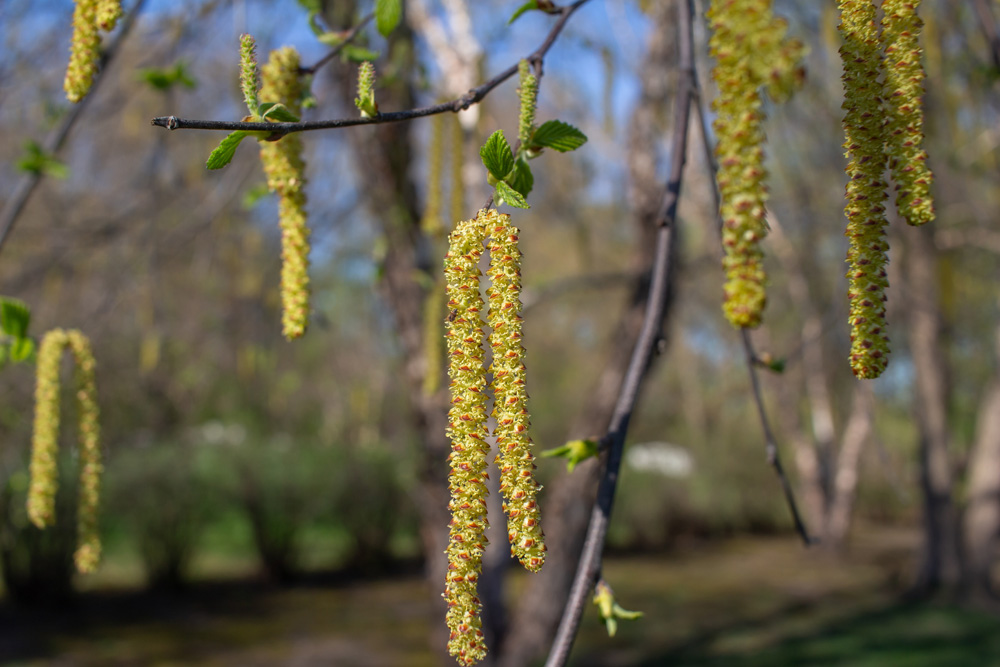
General information:
River birch can grow 50 to 90 feet tall but is often seen 40 to 50 feet. It normally grows with a central leader and small- diameter, dark-coloured lateral branches. It has a narrow, oval to pyramidal crown when young, spreading wider with age as several branches become dominant. It lacks the white trunk bark associated with other birches but is distinguished by reddish, brown bark peeling off in film-like papery curls providing interest all year round. River birch can be easily trained with one central leader or as a multi-stemmed tree. Some nurseries plant two or three trees together to form a clump, but these trunks will not fuse into one strong trunk. Should be grown more as a single-trunked specimen. Branches droop particularly when they are wet, so regular pruning in the early years will be required to remove lower branches when they are located close to areas where clearance is needed.
The river birch occurs along stream beds from Massachusetts to Florida, zones 4 through 9A. It prefers moisture, but will tolerate dry soils.
Birches are much loved for bonsai because of their elegant beauty, but they do not take easily to pot culture. Their short lives are also seen as a disadvantage; however, some birches will live as long as 300 years.
Family:
Betulaceae
Lighting:
Unlike most birches, the river birch prefers partial shade, and may suffer leaf burn if kept in full summer sun.
Temperature:
River birch thrives in zones 5-8. It may need protection from cold winds to prevent twig die-back.
Watering:
The river birch thrives in wet areas, and appreciates lots of water. Feeding: Wait one month after leaves open, then feed every two weeks till the end of summer.
Pruning and wiring:
River birch leaves will reduce significantly, to 1 1/4 inches, perhaps even smaller. Unlike many birch species, river birch does not seem to share the common problem of excessive “bleeding” after pruning, which makes this species easier to work with as a bonsai. Pruning upward branches at the second internode will encourage foliage to extend away from the trunk, opening the branch structure and keeping foliage from massing on branches parallel to the trunk.
Pests and diseases:
Pests:
No pests are of major concern. Resistant to bronze birch borer.
Diseases:
Leaf spots; chlorosis on soils with a high pH.
Repotting:
Birches younger than age 10 will need repotting every two-three years. Older trees need repotting as necessary. Repot in spring, before bud burst, using rich, acidic soil mix. Care should be taken to protect the bark when wiring. The tree may sucker from the roots; these should be removed quickly to keep from sapping the vigour of the main trunk.
Bibliography:
Tomlinson’s “Complete Book of Bonsai”
Resnick’s “Bonsai”
“The Creative Art of Bonsai” by Isabelle and Remy Samson
“Simon and Schuster’s Guide to Bonsai”
Species information from Mitchell’s “American Nature Guides: Trees,” and “The Hearst Garden Guide to Trees and Shrubs.”
USDA Fact Sheet ST-94
Compiled by Sabrina Caine Edited by Thomas L. Zane
Betula sp.
Common Name:
Birch
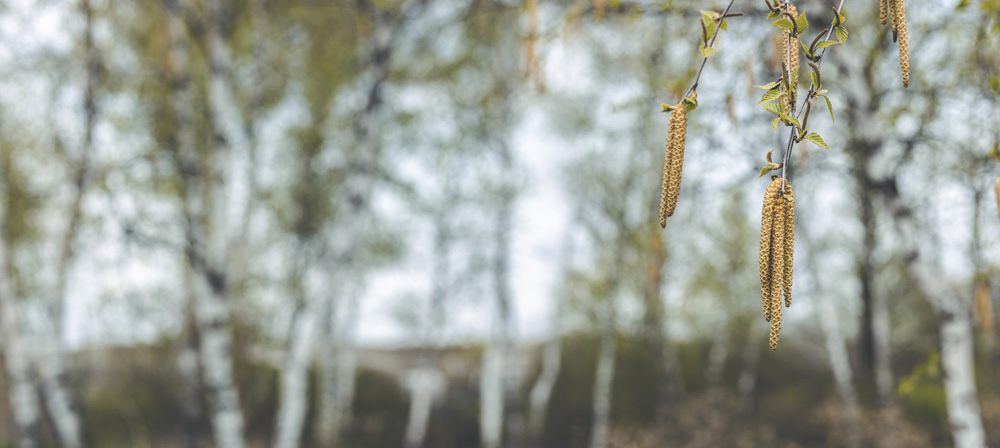
General information:
Birches are pioneer trees, meaning that they grow in open fields, and grow rather quickly at that. They are thus short-lived, usually dying back between age 60-100, and they will not grow in the shade. Birches have peeling bark and pendulous catkins. Many birches have a distinctive white bark which is colored by a pigment called, appropriately enough, betulin. A few birches, such as the yellow birch and sweet birch will grow in the south, but most birches prefer colder climates.
Birches are much loved for bonsai because of their elegant beauty, but they do not take easily to pot culture. Their short lives are also seen as a disadvantage; however, some birches will live as long as 300 years.
Lighting:
Birches like a lot of light, although some shade is advisable in the hottest areas or in midsummer.
Temperature:
Birches are very cold hardy, but may need protection from cold winds to prevent twig die-back.
Watering:
Birches like frequent watering, although they should not be left to stand in moisture. Reduce water in winter, but never let the soil dry completely.
Feeding:
Wait one month after leaves open, then feed every two weeks till the end of summer.
Pruning and wiring:
Trim back shoots to the first pair of leaves throughout growth. It is wise to make large pruning cuts late in the season, as birches “bleed” profusely when the sap begins to run.
Propagation:
Propagation methods vary depending on the species. Betula pendula grows most reliably from seed; cuttings root only with difficulty. Cultivars of this species need special measures to root successfully. Some suggestions from Brent Walston of the Internet Bonsai Club that will work for B. pendula ‘Trost’s Dwarf’ and ‘Youngii’:
Growing them from cuttings is possible, but difficult. As with all birches the timing is critical. The best time is get them just before end bud set in mid summer. This will vary from region to region, in Northern California, the ideal time seems to be early July. For those that have never noticed, terminal buds develop throughout the growing season only to open into new leaves until mid to late season when instead of expanding the bud hardens in preparation for dormancy and opening the following spring. This is called bud set. Before bud set the buds are green, but the set buds turn brownish as they harden. Birches root best just before set, so look for intact buds that you think are not going to open and take the semi hardwood cuttings while the buds are still bright green. Use hormex 8 or IBA 0.8%. Keep the cuttings cool and moist, if they root the buds will break and you will get some new growth before the end of the season. This is nearly essential for overwintering them.
Other species, such as Betula nana, are reputed to root easily from cuttings.
Repotting:
Birches younger than age 10 will need repotting every two-three years. Older trees need repotting as necessary. Repot in spring, before bud burst, using free-draining soil mix. The bark may take up to ten years to turn white in pot culture, but this can be expedited by a few years in a growing bed. Care should be taken to protect the bark when wiring. The tree may sucker from the roots; these should be removed quickly to keep from sapping the vigour of the main trunk.
Pests and diseases:
Pests and assorted obstacles: Bronze birch borer, birch leaf miner. Proper watering and a good fertilization in early spring have been reported to help stave off miner attacks. B. pendula ‘Trost’s Dwarf’ must be shipped only when dormant or the tree may become sick or die. This may be due to abrupt change in lighting, climate etc. and may be a consideration if the tree is to be transported any great distance. Birch may “bleed” to death if pruned out of season. It has been my experience that birch can be sickly in pot culture and shocks easily when root pruned.
Some species suitable for bonsai:
Betula alleghaniensis: yellow birch - A native of northeastern America, reaching as far south as Georgia, the yellow birch can reach up to 70 feet tall. Its bark is a pale gray- brown, and peels off in rolls. It has larger leaves than most birch.
Betula lenta: black birch, sweet birch, cherry birch - In nature, grows in moist, cool woods east of Ohio, further south than most birches, ranging from Ontario to Alabama. Its bark is gray-black or reddish- brown. Its oval leaves turn brilliantly gold in the fall, and it can grow up to 70 feet. Used in the manufacture of oil of wintergreen, this tree is very nice smelling.
Betula maximowicziana: monarch birch.
Betula nana: dwarf birch, Arctic birch - The dwarf birch is especially recommended for bonsai because of its tiny leaves, which show a fine red-gold autumn color. It also has a copper colored bark. It is native to the far north up to the Arctic circle, and can survive on only three months of sunlight a year!
Betula papyrifera: paper birch, white birch, canoe birch: The shiny white bark of this birch was used by Native Americans to build canoes, hence the name. It grows in northern climates, zones 2-6. The leaves are heart-shaped, from 2-4 inches long, yellowing in autumn. It can grow up to 90 feet, but usually not more than 70, and takes on an oval habit. It is susceptible to bronze birch borer.
Betula pendula: the European white birch, silver birch - This tree has silver-white bark with black, diamond-shaped markings. Its heart shaped leaves turn gold in the autumn. A cold climate tree native to Europe, it has been planted as far south as Maryland, but prefers zones 3-5. It can grow to 60 feet, and the branches tend to weep. Many trees in the north-east have been devastated by the bronze birch borer.
Betula pendula ‘Fastigata’
Betula pendula ‘Lanciniata’
Betula pendula ‘Purpurea’
Betula pendula ‘Trost’s Dwarf’: This dwarf only grows 3-4 feet, and is highly sought after for bonsai. It has leaves unique for birch, which resemble those of a threadleaf maple. The leaves are about 2 inches and the tree will grow to 4 ft. tall. It is more light tolerant than most birches.
Betula pendula ‘Youngii’: The small leaves, very white bark and excellent ramification of this tree make it very desirable for bonsai. It weeps naturally, without wiring, and can easily be twisted into serpentine shapes.
Betula platyphylla Japonica: Japanese white birch
Betula populifolia: gray birch - The gray birch is identifiable by its leaves, long-tailed and pointed, which have Pale yellow autumn color. The bark is white with black markings where branches have arisen. It is native to Northern America.
Betula pubescens: smooth-bark birch
Compiled by Sabrina Caine
Carpinus sp.
Common Name:
Hornbeam
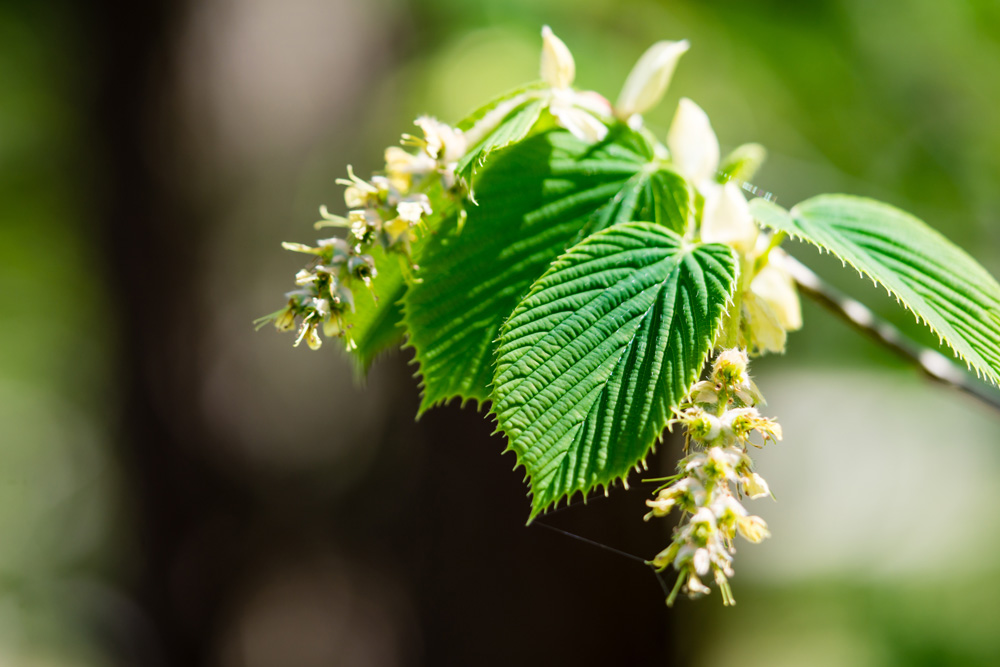
General Information:
A handsome tree in many locations, the tree slowly reaches a height and spread of 20 to 30 feet. It will grow with an attractive open habit in total shade, but be dense in full sun. The muscle-like bark is smooth, gray and fluted. Ironwood has a slow growth rate and is reportedly difficult to transplant from a field nursery (although 10-inch-diameter trees were moved with a 90-inch tree spade during the winter in USDA hardiness zone 8b with no problem) but is easy from containers. The fall colour is faintly orange to yellow and stands out in the landscape or woods in the fall. Brown leaves occasionally hang on the tree into the winter.
Family:
Betulaceae
Lighting:
Partial shade in summer, otherwise full sun.
Temperature:
Fairly cold hardy - zones 3 through 9A.
Watering:
Moderate, increasing in summer. Never let the soil dry completely.
Feeding:
Feeding instructions vary greatly. Simon and Schuster’s Guide recommends feeding Every 20-30 days, stopping for a month-long break in midsummer. The advice to stop feeding in July-August is echoed by the Samsons. Tomlinson is far more aggressive, recommending a weekly feeding for the first month after bud-burst, switching to every two weeks until late summer. Ordinary plant food at half strength is fine, as is bonsai fertilizer. Of course, the whole controversy can be avoided with time- released pellets. Do not feed for two months after repotting. C. laxiflora may experience branch die-back if underfed.
Pruning and wiring:
Elliptical, heavily veined leaves with pointed tip. Can be wired from spring to autumn - some bark protection may be needed, but the hornbeam is fairly sturdy for a deciduous tree. Accepts repeated pruning, quickly healing scars. Prune back to the first pair of leaves on new shoots. The best times for minor pruning are early spring and after flowering. Major developmental pruning should be done in late winter, before bud burst. Strong apical growth of upper part of tree, so it may be necessary to cut back radically at the apex, but to prune the lower portions of the tree conservatively, especially with the Japanese species, to check its rapid apical growth. Defoliation to reduce leaf size is possible, but will inhibit flowering and fruiting. As it ages branches die, complicating management as a bonsai. As the tree ages, branches may die back for no discernible reason.
Propagation:
From seed. Fresh seed in fall is best - sow immediately. Otherwise, seed must be cold treated and planted in late winter. Seed which has been dried may need up to a year to germinate. Murata warns that it is difficult to get viable seed from C. japonica, as there is little overlap in flowering time between the male and female flowers. May also be propagated by cuttings and air layering in spring.
Repotting:
Every 2-3 years in early spring. Use basic bonsai soil. Prefers a deep pot.
Pests and diseases:
Pests: Relatively few insects attack hornbeam. Maple phenacoccus forms white cottony masses on the undersides of the leaves. Diseases: None are normally very serious. Several fungi cause leaf spots on Carpinus. Leaf spots are not serious so control measures are usually not needed. Canker, caused by several fungi, causes infected branches to die back and entire trees die if the trunk is infected and girdled. Severely infected trees can not be saved and infected branches are pruned out. This could limit usefulness in parts of the Deep South.
Some species suitable for bonsai:
Carpinus betulus: hornbeam, European hornbeam, European ironwood. Can grow to 50 ft., but is usually shorter. It has 4 inch leaves and catkins, and drooping clusters of fruit. Its autumn coloucolorr is yellow- green, and it has grey bark. Hardy in zones 5-7.
Carpinus caroliniana (C. americana): American hornbeam, blue beech, water beech - Native to eastern North America. A small - under 20 ft. - tree with a rounded habit and generally prone to multiple trunks. Tolerates both wet soil and shade, but does not like to be transplanted. Nice orange and yellow autumn show. Hardy in zones 3- 8.
Carpinus coreana: Korean hornbeam - Has very twiggy branching and a spectacular fall display with leaves that turn yellow, orange and red, sometimes in bands on the same leaf!
Carpinus japonica: Japanese hornbeam, Japanese carpinus - nice flowers in spring. Smooth pink-grey bark.
Carpinus laxiflora: Japanese hornbeam, Japanese loose-flowered hornbeam, Loose-flowered hornbeam - smooth, grey-beige trunk, small, glossy leaves.
Carpinus tschonoskii: Yedoensis hornbeam, Yeddo hornbeam, Carpinus turkzaninowii: Korean hornbeam, Turkish hornbeam - yet another hornbeam reputed to have a wonderful fall display. Has very small leaves.
Bibliography:
“The Hearst Garden Guide to Trees” by William Thomas (ed.) “American Nature Guides: Trees” by Alan Mitchell
“Bonsai” by Susan M. B. Resnick
Simon and Schuster Guide
“The Creative Art of Bonsai,” by Isabelle and Remy Samson Gordon Owen’s “Bonsai Identifier”
Harry Tomlinson’s “Complete Book of Bonsai”
“Four Seasons of Bonsai,” by Kyuzo Murata
Florida Bonsai XIV:2: pg. 38-50. USDA Fact Sheet ST-120
Compiled by Sabrina Caine Edited by Thomas L. Zane
Chaenomeles sp.
Common Name:
Quince
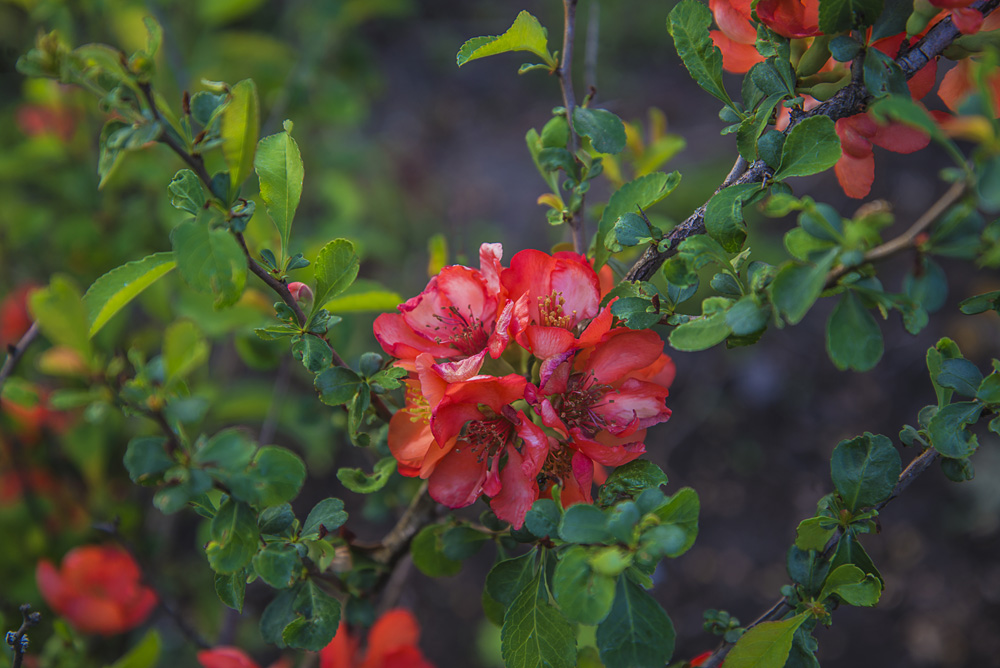
General Information:
Chaenomeles are much beloved for bonsai because of their tiny, lovely flowers, and in spite of their prickly thorns. Most varieties flower before leafing out, sometimes as early as January, and may continue to flower for a long time following. The fruit is yellow and large, too hard to be edible, but making tolerable preserves.
Taxonomists have suffered much over Chaenomeles. To begin, the species now known as C. japonica and C. speciosa were hopelessly confused when introduced into England. They were originally classified as pears, but then reclassified as quinces, and then classified as pears again! Finally, when the genus Pyrus got too large, they were given their own genus. Then the Chinese quince, Chaenomeles sinensis, was reclassified as Pseudocydonia sinensis - false-quince. To make things worse, C. japonica and C. speciosa hybridize at the drop of a hat (called C. x superba), which has made it difficult to know the true derivation of some cultivars (many are simply identified as C. ‘CultivarName’.)
Lighting:
Full sun, although partial shade in midsummer is desirable in very hot areas.
Temperature:
Protect from frost.
Watering:
Generous, but avoid misting as this damages the flowers and may rot the fruit. Reduce watering in winter, but never allow the soil to become fully dry.
Feeding:
Every two weeks from the end of flowering until fall. Some varieties have spot blooms throughout the season; these obviously still need to be fed when growing actively. Use liquid bonsai fertilizer or half- strength plant food. Proper feeding is essential for good flowering. Calcium in the soil helps to form fruit and flowers.
Pruning and wiring:
Fruiting and flowering can sap the plant’s energy dramatically, so it is wise to limit the amount by picking off developing fruit and flower buds, especially in young bonsai. Flowering quince likes to sucker from the roots. Suckers should be removed if a thick trunk is desired; however, thick trunks can be difficult to achieve, especially in some popular C. japonica cultivars such as ‘Chojubai.’ These plants are most often grown in clump style. Some species may need to be cut back hard to encourage branch formation. New shoots should be cut back to 1-2 leaves after 5-7 leaves have formed, which may be as often as every two weeks in a vigorous plant. Chaenomeles can be wired from spring through the end of summer, leaving the wire on for up to four months, and can be repeated yearly.
Propagation:
From seeds, which need to be cold-treated before sowing in spring, but will germinate rapidly. Softwood cuttings may be taken in summer,or hardwood cuttings in winter, but cuttings will root slowly. Clumps may be propagated through division. Named hybrids are often propagated through grafting.
Repotting:
Chaenomeles is one of the few species which prefers to be repotted in autumn, but can also be transplanted in early spring, or even summer if the top is properly cut back. The books recommend repotting every 2-4 years, But Brent has found that (at least in the California sun!) they may need yearly repotting. Use rich but well-drained soil. Roots can be cut back by about half if necessary.
Some species suitable for bonsai:
Chaenomeles ‘Cameo’ - peach-colored flowers.
Chaenomeles cathayensis - Hardy to zone 6, with pink or white flowers.
Chaenomeles ‘Hime’ - Has bright red flowers with yellow anthers. Chaenomeles ‘Iwai Nishiki’ - has 2 inch, bright red double-flowered blooms that form in clusters.
Chaenomeles ‘Kurokoji’ - the cultivar with the darkest red flowers, almost like velvet.
Chaenomeles japonica (also called C. maulei): Maul’s flowering quince, Japanese flowering quince, Japanese quince - a very popular bonsai, the original varieties have red, salmon or orange flowers. Grows to three feet tall. Hardy in zones 5-8.
Chaenomeles japonica ‘Chojubai’: Chojubai quince.
Chaenomeles ‘Orange Delight’ - This cultivar, with its orange flowers, pale leaves and low-growing habit, is a sure-fire fruit former. Chaenomeles ‘O Yashima’ - forms huge fruit.
Chaenomeles speciosa (also called C. lagenaria) - These plants have shiny, toothed oval leaves which stay green well into autumn, and will grow up to six feet. Zones 5-8.
Chaenomeles speciosa ‘Nivalis’: white flowering quince. Chaenomeles speciosa ‘Rosea Plena’.
Chaenomeles speciosa ‘Toyo Nishiki’ - Its outstanding feature is that it may bear red, white and pink flowers all on the same plant. Not all plants bear red flowers, and a plant may not have red flowers every spring. Murata claims that only plants of 50 years or older have red flowers. This would not explain lack of red flowers on a previously red plant. Strangely, grafts and cuttings made from old plants usually don’t have red flowers for a few years.
Chaenomeles x superba - a hybrid between C. lagenaria and C. japonica.
Chaenomeles x superba ‘Corallina’ - Red/orange flowers. Chaenomeles x superba ‘Crimson and Gold’.
Chaenomeles x superba ‘Etna’ - vermillion flowers.
Chaenomeles x superba ‘Incendie’.
Chaenomeles x superba ‘Pink Lady’ - rose pink flowers.
Bibliography:
Jahn (ed.) “The Simon and Schuster Guide to Bonsai” Murata’s “Four Seasons of Bonsai”
Owen’s “Bonsai Identifier”
Resnick’s “Bonsai”
Samson’s “Creative Art of Bonsai’
Tomlinson’s “Complete Book of Bonsai”
Species information from Coats’ “Garden Shrubs and Their Histories,” and Thomas (ed.) “The Hearst Garden Guide to Trees and Shrubs.”
USDA Fact Sheet ST-402
Compiled by Sabrina Caine
Edited by Michael Johnson and Thomas L. Zane
Crataegus sp.
Common Name:
Hawthorn
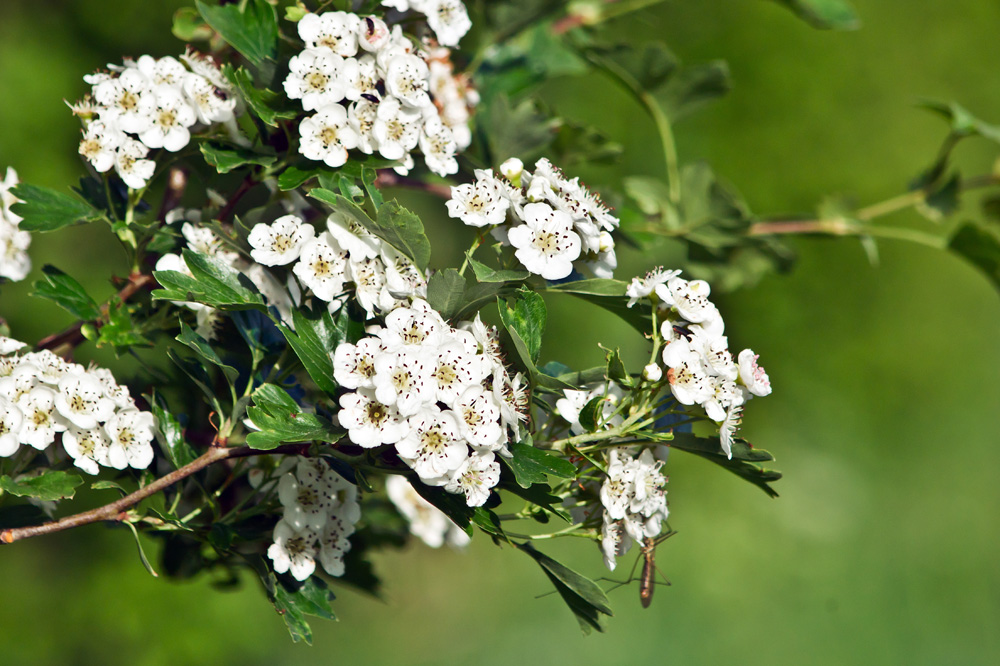
General information:
This slow-growing native North American tree reaches a height of 30 feet with a rounded canopy that spreads to 35 feet or more. The dark green, deciduous leaves are often three-lobed and have red/brown undersides. The leaves display no appreciable fall color. The sparkling white, showy springtime flowers appear before the new leaves unfurl and are followed by the production of large, red-dotted fruits. The spreading, low branching habit of growth makes this best suited for planting in a large open area of turf.
There are a large number of hawthorns, and a large amount of variation within the genera. Most are small and thorn-bearing, with clusters of flowers in late spring or early summer followed by red, apple-like fruit, called haws. Another valuable feature for bonsai is the quick, fine branch ramification.
Family:
Rosaceae
Lighting:
Full sun, partial shade in the hottest part of midsummer.
Temperature:
Zones 6 through 11.. Most hawthorns dislike extreme heat. Resistant to windy conditions.
Watering:
Generous - do not allow the soil to dry out completely. Increase the amount of water in the summer. C. marshalii is an especially thirsty plant, as its native habitat is marsh, and will die if ever allowed to dry out. Hawthorn likes to be misted in dry weather, but avoid misting the flowers when in bloom. Moisture trays can be used to provide needed humidity, especially for C. marshalii.
Feeding:
Every 14-30 days from spring-autumn, stopping for a month in midsummer. Use half-strength plant food or bonsai food.
Pruning and wiring:
Prune back shoots to the first two leaves as necessary. Hawthorn grows quickly and needs constant pruning to keep under control. The best time for major branch pruning is before the leaves come in, as the intricate structure of the branches may be clearly viewed. May be wired during spring and summer. Remove faded fruits and flowers; it may be necessary to remove some of the fruit from young bonsai to prevent the plant from exhaustion.
Propagation:
May be grown from seed, but will not flower until at least 20 years old, which makes cutting grown and grafted plants the better option. Needs cold treatment before sowing, and the Samsons warn that it may take up to three years for the seeds to germinate. Air-layering may be used in spring, softwood cuttings in summer, and grafting in late winter or early spring. Crataegus laevigata ‘Paul’s scarlet’ rarely fruits and is usually propagated by grafting.
Repotting:
Every 1-3 years in early spring or autumn. Always leave a strong root system. Up to 1/3 of the root mass may be removed if the tree is a strong grower, but hawthorns are sometimes prone to rooting problems.
Pests and diseases:
Gall-forming aphids, caterpillars, powdery mildew, scab, rust, leaf blight, bacterial fireblight. May experience rooting problems.
Some species suitable for bonsai:
Crataegus ambigua: Russian hawthorn, Russian thorn apple Crataegus crus-galli: cockspur thorn, hog-apple, Newcastle thorn - White 1/2 inch flowers follow the leaves in spring. It has dull red fruit which persists till the following spring, and excellent wine-red fall color. This hawthorn grows to 25 feet, with 4 inch (!!!) long thorns, and is hardy in zones 4-6.
Crataegus cuneata: hawthorn, ornamental thorn, Japanese hawthorn - small lobed leaves, white flowers in spring, large fruit.
Crataegus douglassii: black hawthorn - named for its black fruit, the spines are small (under 1 inch) or often absent.
Crataegus laevigata (also called Crataegus oxycantha): English hawthorn, double-flowered hawthorn - A native of Europe, this small tree grows only to 20 feet. It has little fall color, and the fruits are not showy. Its outstanding feature is its flowers, which can be white, pink or red. Hardy in zones 5-7.
Crataegus laevigata ‘Paul’s scarlet’: double red-flowering hawthorn, Paul’s scarlet thorn - a very desirable variety due to the spectacular red double-flowers. Rarely fruits, so is mainly propagated by grafting.
Crataegus x lavallei: Lavelle hawthorn - A hybrid between C. crus- galli and C. pubescens. Notable for its 3/4 inch white flowers in late spring, showy orange-red fruit and bronze-red autumn color. Another advantage of this species is the lack of thorns. It grows to 20 feet, and is hardy in zones 4-7.
Crataegus marshalli: parsley-leaved hawthorn - a very small tree, growing only 15-18 feet in its natural habitat, the marshy areas of Florida and Southern Georgia. Parsley- shaped leaves, exfoliating grayish-brown bark, 1/2 inch white flowers, edible yellowish-red fruit. The least hardy of the hawthorns, it is probably best to keep C. marshalii from freezing. Its trunk diameter rarely exceeds 4 inches in the wild. Some have reported that this tree can be sensitive after being collected, and will need special care concerning proper moisture and temperature.
Crataegus mollis: downy hawthorn - a common tree in US parks and cities, this tree gets its name from the downy undersides of its leaves. It bears scarlet or crimson edible fruit with dark spots. It grows to 30 feet in the wild.
Crataegus monogyna: common hawthorn, one-seed hawthorn - a commonly seen hawthorn because it is hardy and adaptable. Besides its use in bonsai, it makes an excellent hedge. Very fragrant white flowers, red haws in autumn.
Crataegus nitida: glossy hawthorn
Crataegus phaenopyrum: Washington hawthorn - A native of the Eastern US, this is one of the larger hawthorns at 30 feet. It has 2 1/2 inch leaves which resemble maple leaves, and orange fruit which lasts into the winter. Hardy in zones 4-7.
Crataegus punctata: dotted hawthorn - Grows to 30 feet. 1/2-3/4 inch 5 petaled white flowers appear in compact, hairy clusters in late spring. Fruit is dull red to yellow with whitish dots. These fruits (nutlets) mature and fall in autumn. It is found growing in moist soils of valleys and rocky upland slopes, especially on limestone.
Crataegus sanguinea: redhaw hawthorn
Crataegus succulenta: fleshy hawthorn, long-spine hawthorn,
Crataegus - Hawthorn succulent hawthorn - grows to 20 feet and has bright red fruits which mature in autumn.
Crataegus viridis: Winter King hawthorn, green hawthorn, Southern hawthorn - Rich green foliage, white flowers in late spring and orange- red fruit until late winter. This large hawthorn grows to 40 feet, and its spreading habit can be equally as wide. Exfoliating bark. Likes wet feet. Hardy in zones 5-8.
Bibliography:
USDA Fact Sheet ST-209
Compiled by Sabrina Caine Edited by Thomas L. Zane
Euonymus sp.
Common Name:
Burning Bush
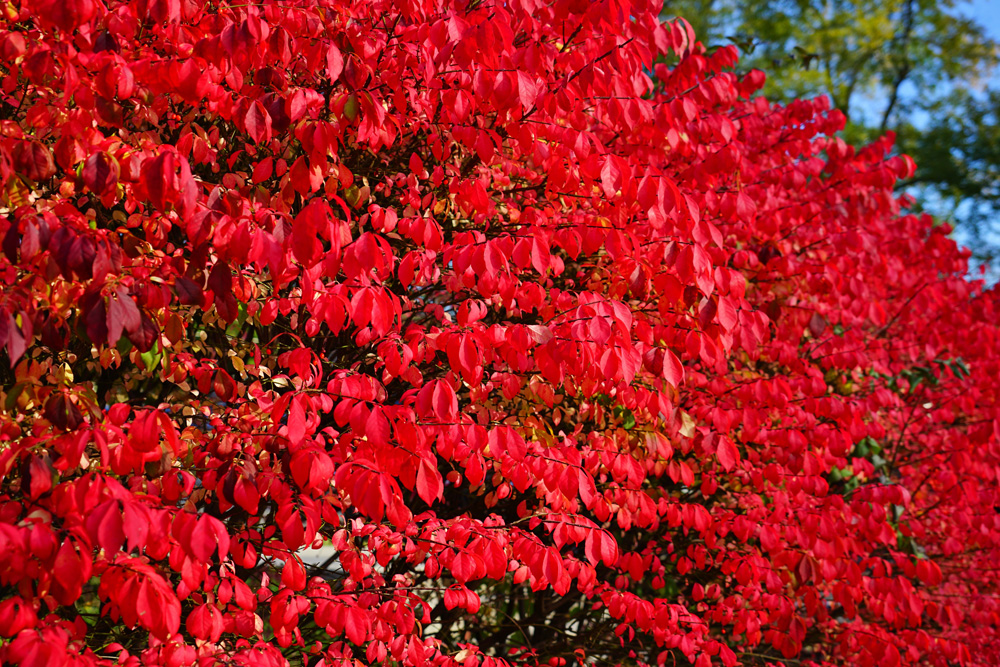
General information:
The spindle tree, or burning bush, is popular as an ornamental shrub for its brilliant red autumn coloration and for the interesting “wing” structures which form on the branches. Bonsai enthusiasts differ on this point: Jahn and Tomlinson, for example, finds the wings an interesting feature, whereas Murata considers them a nuisance. Both evergreen and deciduous varieties of spindle tree can be used for bonsai.
Lighting:
Needs a lot of indirect light, but only limited exposure to full sun.
Temperature:
Varies according to species, with some Euonymus being quite hardy (to zone 4) while others being considerably more tender. Tender varieties can be kept indoors during winter, but need outdoor light and air come spring. Small sized Euonymus bonsai need frost protection for their roots.
Watering:
Moderate. Do not allow the soil to dry out. May appreciate daily misting during growth.
Feeding:
Every two weeks from late spring through summer. Use bonsai food, half-strength plant food or timed-release pellets.
Pruning and wiring:
Cut back new shoots to 2-3 leaves. Can be wired during spring and summer, but protect the delicate bark. A single plant will flower, but if fruiting is desired, several specimens are required for cross- pollination. E. sieboldianus has naturally long internodes, and Murata warns that attempting to make the tree look “restrained” will seem artificial. He encourages bonsaists to appreciate the “unrestrained” nature of the tree. Those who find the wings unattractive or out of proportion in their bonsai often choose to remove them.
Propagation:
Seed, layering in spring or summer, softwood cuttings in summer, hardwood cuttings in autumn.
Repotting:
Every 2-3 years in early spring, although yearly repotting may be necessary during the tree’s first ten years depending on root growth. Use basic bonsai soil mix.
Pests and diseases:
Caterpillars, aphids.
Some species suitable for bonsai:
Euonymus alatus: winged spindle, burning bush, corkbush, winged euonymus - Remarkable autumn color, with purple-pink leaves and small orange fruits. Originally native to northeastern Asia, it can grow to 15 feet. Hardy in zones 4-8.
Euonymus alatus form. ciliatodentatus: ko-mayumi, spindle tree - This particular Euonymus lacks the “wings” which characterize most of the species.
Euonymus bungeana: winterberry euonymus
Euonymus - Burning bush
Euonymus europaeus: European spindle-tree - Another colorful Euonymus, with scarlet seed capsules and pinkish-orange fall color. This European native is taller than other Euonymus species, growing to 20 feet. Hardy in zones 4-7.
Euonymus fortunei: wintercreeper euonymus - Youthful plants assume a creeper habit which is suitable only for cascades, but the mature plant develops a bushy habit and a firm woody trunk. Cuttings taken from older plants retain the bushy habit. Has many forms, most frequently variegated. Hardiness depends on the variety, with some forms able to survive New England winters, but some tender variegated forms.
Euonymus japonica ‘variegata’: Japanese spindle tree, evergreen euonymus - This evergreen can be brought indoors for the winter where it is not zone hardy. A winter temperature of 46-59F is preferable. It grows to 12 feet, and has glossy leaves reminiscent of box. Hardy in zones 7-9.
Euonymus kiautschovica: spreading euonymus - The smallest Euonymus, it grows only to 10 feet. Evergreen in the warmer areas of its range, but in colder climates may lose many of its leaves and emerge from winter looking ragged. Hardy in zones 6-9.
Euonymus sieboldianus: Japanese spindle tree - pale green flowers, pinkish-white fruits and red seeds.
Euonymus sieboldianus cv. ‘Fastigiatus’: tachi-mayumi, spindle tree.
Compiled by Sabrina Caine Edited by Thomas L. Zane
Fagus sp.
Common Name:
Beech
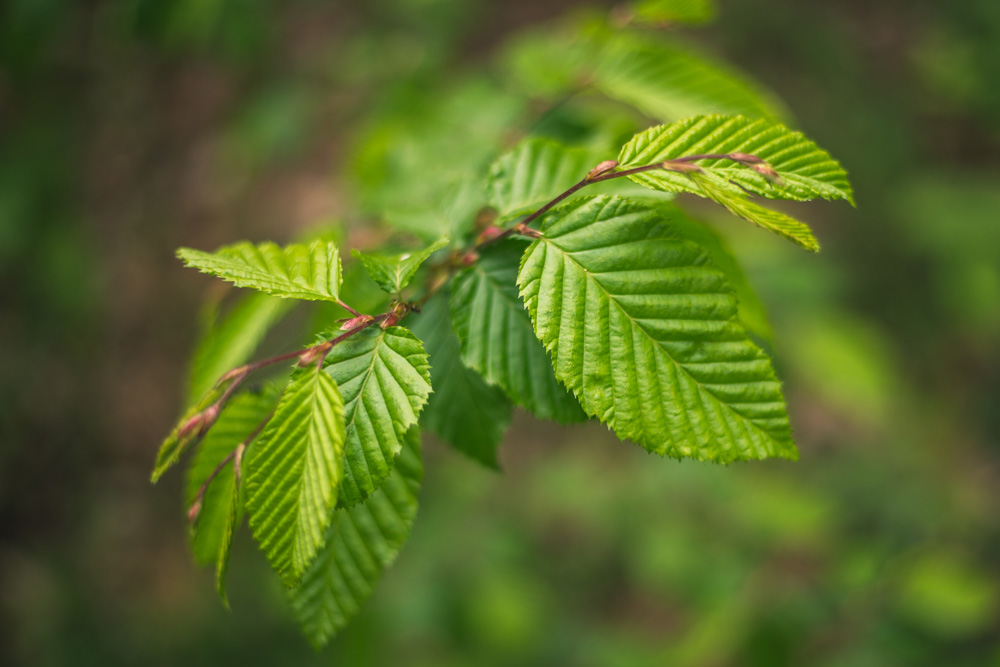
General Information:
This massive tree will slowly reach a height and spread of 50 or more feet. Forest grown trees reach up to 120 feet. The tree is naturally low-branched with attractive glossy green leaves providing deep, inviting shade. Little grows in the dense shade of a Beech tree but if low branches are left on the tree no ground cover or grass is needed. In the fall, the leaves turn bronze but weather to a light tan color. Some leaves are held late into the winter if not blown off by the wind and the thin, smooth, silvery-gray bark is quite ornamental. The bark looks like elephant skin on older specimens. The four tiny nuts in each spiny bur of this American native are much prized by birds and various mammals, including man. The wood is almost white and is used most often in toys, cookware, furniture and for barrels which age beer. The tree is very resistant to decay under water so it was used to make water wheels in Colonial times. The wood is also used for tool handles, chairs, cuttings boards, and for making charcoal.
The beech genera is a small one, comprised of about a dozen species. They have smooth, pale gray bark, and ovate leaves which look similar to those of the hornbeam. The most distinctive feature of the beech is its unmistakable cigar-shaped buds. These buds are rather tender, and beech does not produce secondary buds. Nature’s way of protecting these buds is for the beech to retain its dead leaves throughout winter. For this reason - and the fact that they make for an interesting winter bonsai - the beech’s dried leaves should not be removed from the tree. Many lovely and colourful cultivars of beech are becoming available and should gain in popularity in the bonsai world.
Family:
Fagaceae
Lighting:
Full sun, but semi-shade in midsummer.
Temperature:
Hardy in zones 3 through 8. Varies - the American beech is the most hardy, the Japanese white beech the least. All beeches can benefit from winter protection in their early years.
Watering:
Frequently, especially during hot weather, to prevent the edges of the leaves from drying out. Reduce watering in winter. Appreciates misting. If F. sylvatica is watered especially well in late June to early August, it may have a second growth spurt.
Feeding:
Do not feed for the first month after bud burst. Then feed every two weeks until the end of summer. Increasing feeding for F. sylvatica in late June-early August encourages the development of a second growth spurt.
Pruning and wiring:
Leaf pruning every second year in late spring is important to reduce the size of the large leaves. It is safer not to defoliate the beech completely, or in the same year that it has been repotted. Prune new shoots from 3-5 nodes to 1-2 nodes.
Beech grows slowly, and does not require much pruning. However, because beech does not produce secondary buds, it is important not to allow the internodes to become too long. Beech can be wired, but wiring saps the vigour of the tree, and should not be left on longer than three months. The bark of the beech is delicate and needs protection. It is best to do most shaping through pruning. Because of the apical predominance of the plant, prune the top back drastically, but prune lower branches sparingly. Because of its large leaves, beech is generally reserved for medium to large size bonsai. Because beech grows so slowly, it is a long- term project to grow a specimen beech. This is why young beech are often used in forest plantings.
Propagation:
Grafting, seeds sown in autumn (or use cold-treated seeds in spring).
Repotting:
Spring, before bud burst, every 2-3 years. F. sylvatica may be repotted in autumn, taking advantage of its second growth spurt - Simon and Schuster’s states that more drastic pruning of roots can be done in autumn than spring. Use basic bonsai soil mix but prefers loose acid soil.
Pests and diseases:
Pests:
Beech leaf miners, scale, bark beetles, and aphids. Aphid colonies on the lower branches can be dislodged with a strong stream of water from the garden hose. Colonies are often disposed of by predatory insects. Borers such as flat-headed apple tree borer or two-lined chestnut borer bore into trees weakened by stress. Prevent the insect infestations by keeping trees healthy with regular fertilization and irrigation in dry weather. Regular inspections of the trunk and branches are suggested for early detection of scales. Beech scale can be devastating to trees in the northeastern United States. Certain caterpillars can be controlled with sprays of Bacillus thuringiensis. Insect identification allows proper spray recommendations to be made.
Diseases:
Usually none are serious provided soil is not compacted and is well-drained. Several fungi cause leaf spots but are generally not serious to warrant chemical control. Powdery mildew causes a white coating on the leaves. The disease is most common late in the season. Bleeding canker forms cankers from which a brownish liquid oozes. Crown symptoms include leaves of smaller size and lighter green colour than normal. In severe cases the leaves wilt and the branches die. Avoid feeding with high nitrogen fertilizers as it seems to worsen the condition of infected trees. Beech bark disease occurs when the feeding site of woolly Beech scale is invaded by a fungus. The fungus kills the bark and in the process, the insects. There are no satisfactory controls for the fungus. Control the disease by controlling the scale with a horticultural oil. Cankers infect, girdle, and occasionally kill branches. Prune out the infected branches. During periods of high temperatures and low rainfall Beech may scorch. Make sure trees are adequately watered and mulched.
Some species suitable for bonsai:
Fagus crenata: Japanese blume, Japanese white beech, Siebold’s beech - more suitable for bonsai than its European counterpart due to its slightly smaller stature and leaves. The bark is sometimes bleached with lime sulfur to accentuate its white color.
Fagus grandifolia: American beech - With its pale, silvery bark and rich green leaves, the American beech is considered a more desirable landscape plant than the European. It is not that common in bonsai, however, perhaps because it grows to over 100 feet, with leaves of 3-6 inches! If proper leaf reduction and dwarfing techniques are used, makes an impressive large sized bonsai. Zones 4-8. Fagus japonica: Japanese black beech.
Fagus sieboldii.
Fagus sylvatica: European beech, common beech - This tree has the darkest gray bark and darkest green leaves of all the beeches. Common in both Europe and America, it grows to a height of 90 feet, with leaves of 3-4 inches. Hardy in zones 5-9.
Fagus sylvatica ‘Asplenifolia’: cut-leaf beech.
Fagus sylvatica ‘Atropurpurea’ (‘Atropunicea’): copper beech - With its copper red to brownish-black foliage, this cultivar is commonly seen on the American east coast and in western Canada. Smooth gray bark, ovate-elliptical leaves. Do not let soil dry out completely. Buds grow very rapidly and it tends to do budding only once at beginning of spring. Pinching is done by removing the incipient leaves when they have almost come out of the bud. Do not defoliate aged specimens or those that were collected from nature. Leaf prune young specimens only once every 2 years.
Fagus sylvatica heterophylla: fern-leaved beech - deeply-cut, lobed leaves.
Fagus sylvatica ‘Lanciniata’: laceleafbeech, fern-leaf beech, cut-leaf beech.
Fagus sylvatica pendula: weeping beech - In nature, an awkward tree in its youth, but develops into a stunning specimen when mature.
Fagus sylvatica purpurea: purple beech.
Fagus sylvatica ‘Riversii’: purple beech - dark purple-black leaves. Fagus sylvatica ‘Rohanii’: purple fern-leaved beech, oak leaf beech - deeply cut purple leaves.
Fagus sylvatica ‘Spathiana’: purple beech - another purple beech, but the best for holding its color deep into the summer.
Fagus sylvatica ‘Tricolor’: tricolor beech.
Fagus sylvatica ‘Zlatia’: golden beech.
Bibliography:
Jahn (ed.) “The Simon and Schuster Guide to Bonsai,” Murata’s “Four Seasons of Bonsai,”
Owen’s “Bonsai Identifier”
Resnick’s “Bonsai,”
Samson’s “Creative Art of Bonsai”
Tomlinson’s “Complete Book of Bonsai,”
Species information from Mitchell’s “American Nature Guides: Trees,” and Thomas (ed.) “The Hearst Garden Guide to Trees and Shrubs”.
USDA Fact Sheet ST-243
Compiled by Sabrina Caine Edited by Thomas L. Zane
Hibiscus syriacus
Common Name:
Rose of Sharon
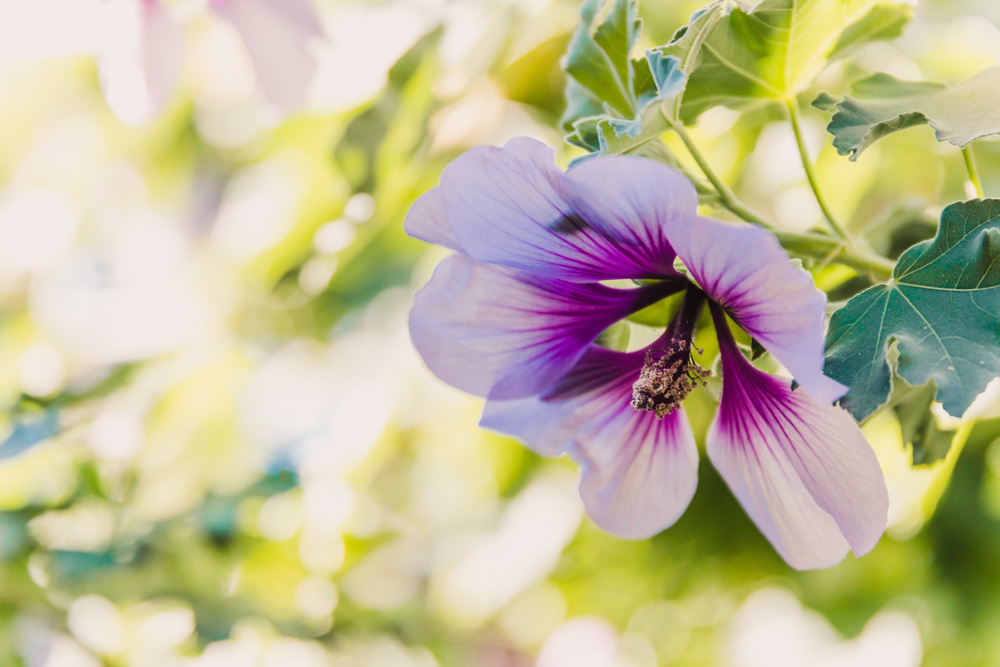
General Information:
Valued in the garden for its large flowers produced in summer. Valued as a bonsai for its upright habit, open and loose branches, light green leaves which can all be enhanced with pruning. Moderate salt tolerance.
Family:
Malvaceae
Lighting:
Part shade to full sun
Temperature:
Zones 5B - 9A.
Watering:
Adequate water to keep from drying out and remaining dry. Requires ample water to flower its best and to avoid leaf drop.
Feeding:
General purpose fertilizer.
Pruning and wiring:
Bark is thin and is easily damaged.
Propagation:
Cuttings.
Repotting:
The tree needs annual repotting. Not particular about the type of soil, however it should be well drained and acidic.
Pests and diseases:
Aphids and Japanese beetles. Diseases include leaf spot, canker and flower blight.
Bibliography:
United States Department of Agriculture, Forest Service, Fact Sheet ST-295
Compiled by Thomas L. Zane
Lagerstroemia sp.
Common Name:
Crape myrtle
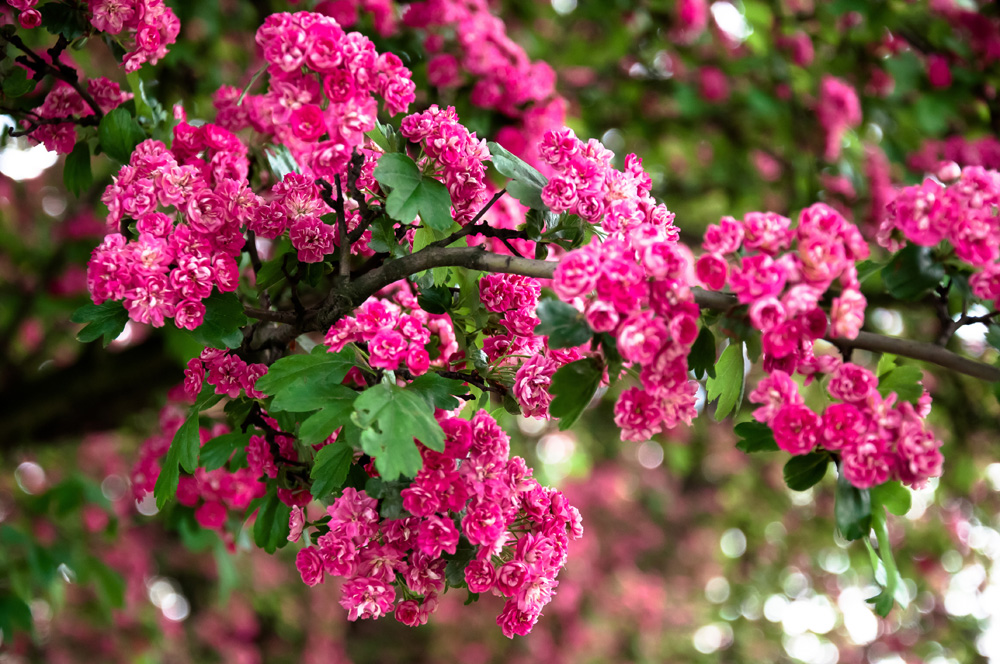
General information:
Crape myrtle makes an excellent bonsai due to its exquisite branch ramification and the contrast of the red upon silver of the peeling bark. Native to Asia, the crape myrtle is very common in the southern US, having been introduced over 150 years ago. It has small pink, white or purple flowers, but is often displayed in winter to show off its trunk and branch structure. It gets its common name from its crepe-like, crinkled petals, and the resemblance of its leaves to the true myrtle, Myrtus communis.
Family:
Lythraceae
Lighting:
Full sun.
Temperature:
Zones 7-9A, although some of the dwarf cultivars can be grown as far north as zone 5. Can be successfully grown as an indoor plant; if this is done it should be kept at a temperature of 45-54 degrees in the winter to stimulate dormancy - the crape myrtle should drop its leaves. If it is exposed to a combination of warm temperatures and low light (as inside many houses in winter) the crape myrtle’s new growth will be leggy and sappy.
Watering:
Frequently in spring, moderately during the rest of the year. Reduce watering in winter and just before flowering to encourage bud formation.
Feeding:
Every two weeks in spring-autumn. Alternate a general purpose plant food or bonsai food with a low nitrogen tomato fertilizer.
Pruning and wiring:
The crape myrtle flowers at the ends of its shoots, so one must take care with pruning if flowering is desired. The safest method is to prune only in autumn, and in any case, a good autumn pruning will stimulate bud production for next year. Betsy recommends cutting the crape myrtle back severely, then allowing it to grow freely for a year to thicken the trunk. The next year, pinch the tree constantly to promote branch ramification. If pruning is discontinued shortly before the flowering period, it may still flower. May be wired from spring to autumn, taking care to protect the bark. The branches are delicate, however, and it is just as easy to shape through pruning due to the excellent branch ramification.
Propagation:
From seed in spring, or by softwood and semi-hardwood cuttings taken in spring or summer.
Repotting:
Every 1-3 years in early spring to summer, most safely done before bud burst. Use basic soil mix.
Pests and diseases:
Pests:
Scale and aphids are other common problems. The plant will only flower during a warm, dry summer.
Diseases:
Powdery mildew, although mildew resistant varieties are available.
Some species suitable for bonsai:
Lagerstroemia - Crepe myrtle
Lagerstroemia hirsuta - this native of India and New Guinea has purplish red or white flowers. Needs temperatures above 50 degrees, but also likes a cooler period in winter.
Lagerstroemia indica: crape myrtle, Chinese crape myrtle - Grows to 20 feet tall, with 9 inch flower clusters. There are many cultivars. Can take temperatures as low as 43 degrees.
Lagerstroemia indica ‘Alba’: white crape myrtle
Lagerstroemia indica ‘Amabilia’: purple crape myrtle
Lagerstroemia indica ‘Cordon Bleu’ - A dwarf with lavender flowers.
Lagerstroemia indica ‘Pixie Pink’ - Very dwarf, with pink flowers.
Lagerstroemia speciosa: Queen’s crape myrtle - This tiny tropical plant grows to only 8 inches. Its flowers are pink to red. Keep at 50-59F in winter.
Bibliography:
USDA Fact Sheet ST-342
University of Florida, Agricultural Extension Service, Fact Sheet ENH-52
Compiled by Sabrina Caine Edited by Thomas L. Zane
Ligustrum sp.
Common Name:
Ligustrum or Privet
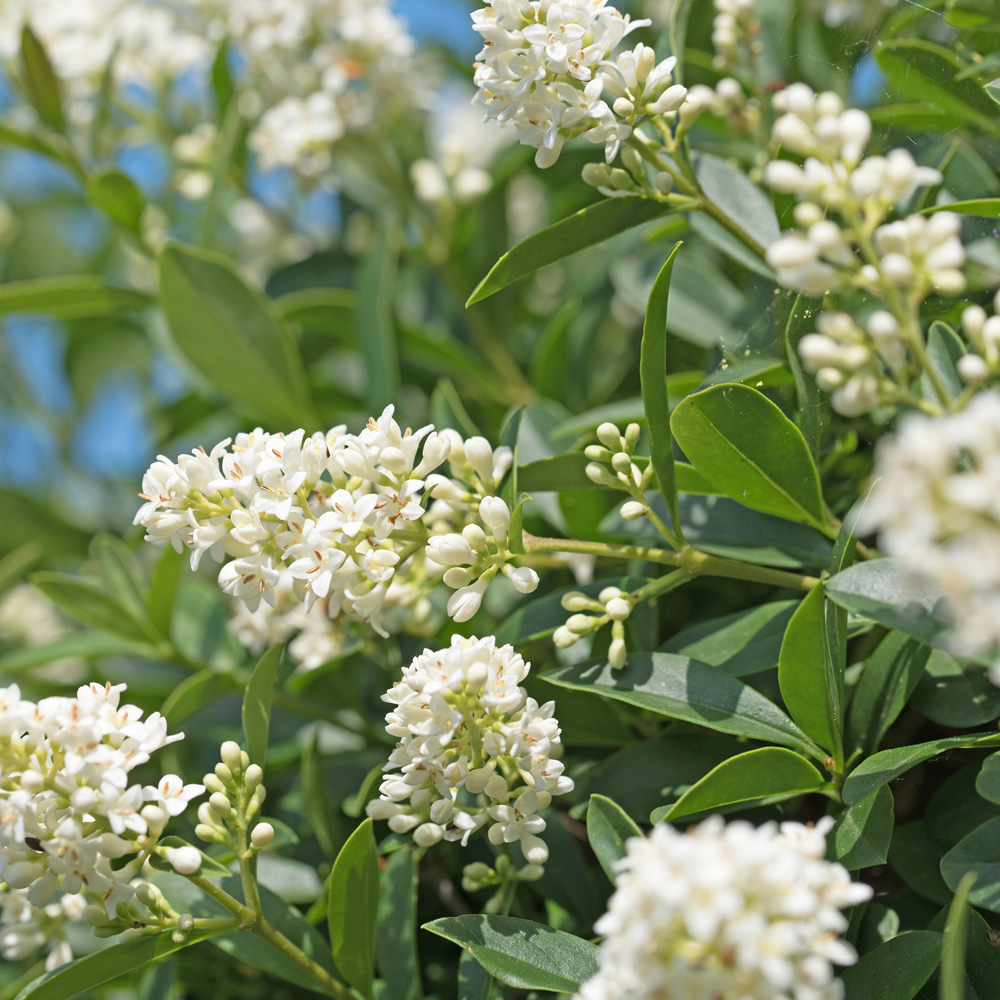
General Information:
Ligustrum, or Privet are found in many species and cultivars with a diversity of leaf colours, leaf forms and growth habits. All are tolerant of heavy pruning. The white flowers are attractive during late spring and early summer.
Family:
Oleaceae
Lighting:
Part shade to full sun
Temperature:
Zones 7 - 11.
Watering:
Adequate water to keep from drying out and remaining dry.
Feeding:
General purpose fertilizer.
Pruning and wiring:
Branching can be encouraged by pinching the stems.
Propagation:
Cuttings, grafting and seeds.
Repotting:
The tree needs annual repotting. Not particular about the type of soil, however it should be well drained.
Pests and diseases: Aphids, scale, white fly and spider mites. Diseases include leaf spot and root rot.
Some species suitable for bonsai:
L. japonicum, Japanese or wax privet.
L. lucidum, Glossy privet. Rapid growing
L. sinense, Chinese privet
L. sinense ‘Variegata’ has small white to yellowish variegated leaves 1 1/2 to 3 inches.
L. japonicum var. roundifolium, also called L. recurvifolium is slow growing, upright with round leaves.
Bibliography:
University of Florida, Florida Cooperative Extension Service, Fact Sheet OH-45
Compiled by Thomas L. Zane
Liquidambar styraciflua
Common Name:
Sweetgum
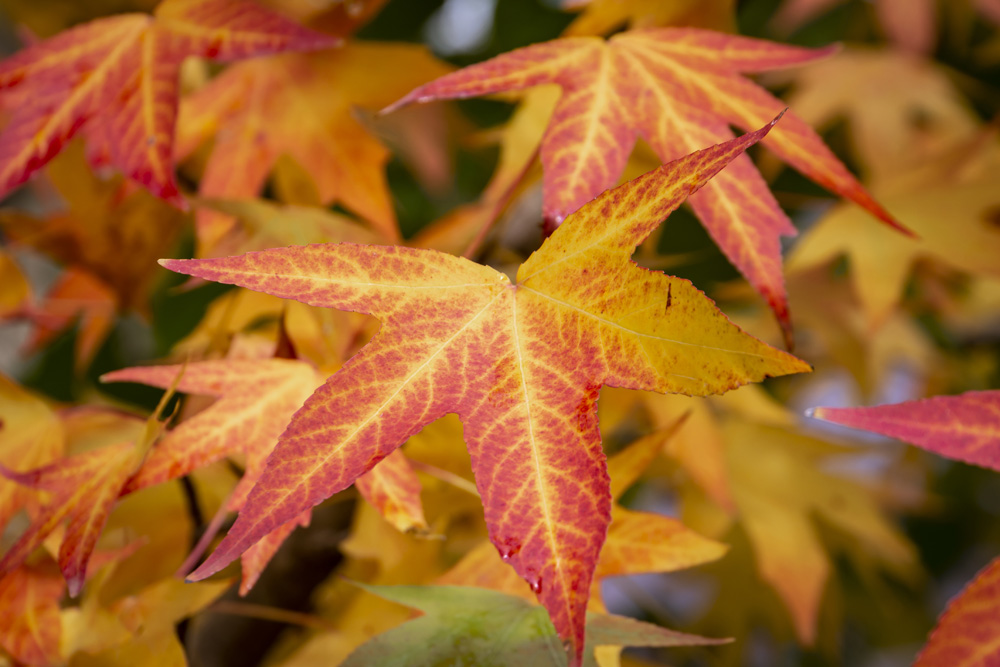
General Information:
Sweetgum grows naturally in a narrow pyramid. It has glossy, star-shaped leaves which turn bright red, purple, yellow or orange in the fall/early winter. The trunk is normally straight and does not divide into multiple trunks. The bark becomes deeply ridged. It is native to North America.
Family:
Hamamelidaceae.
Lighting:
Will grow in full sun or partial shade.
Temperature:
Zones 5B - 10A. More restricted zones may apply to some of the dwarf varieties.
Watering:
It is moderately drought tolerant.
Fertilizing:
To retain and produce small leaves, do not feed high nitrogen fast-acting fertilizers. Feeding three times a year is sufficient to maintain good color and healthy growth without enlarging the size of the leaves.
Pruning and wiring:
Much shaping can be done by pruning.
Propagation:
Cuttings, seeds.
Repotting:
They transplant well. Any type of soil with a pH of 7 or less, and with good drainage seems to grow them well. They have heavy root growth so must have root room.
Pests and diseases:
Bagworm, fall webworm, leaf miner, cottony-cushion scale, sweetgum scale, walnut scale, and tent caterpillars. Diseases include canker and leaf spots.
Bibliography:
USDA Fact Sheet ST - 358
Compiled by Thomas L. Zane
Malus sp.
Common Name
Apple/Crabapple
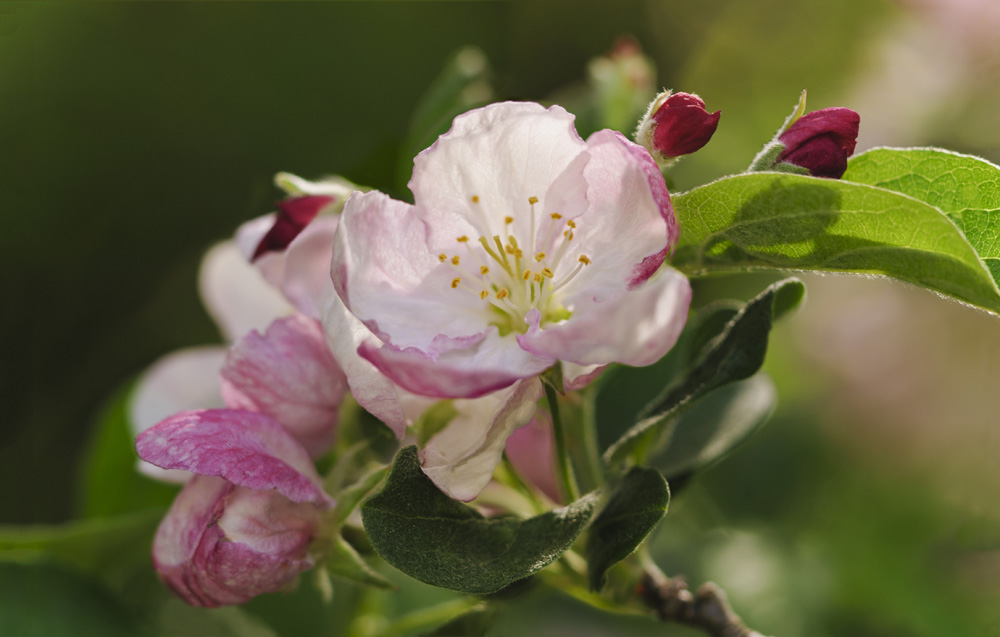
General information:
Apples and Crabapples are best grown in a sunny location with good air circulation and have no particular soil preferences, except soil should be well-drained. Root pruned trees transplant most easily. Tree size, flower colour, fruit colour, and growth and branching habit vary considerably with the cultivar grown but many grow about 20 feet tall and wide. A few Crabapples have good fall colour and double-flowered types hold blossoms longer than single-flowered cultivars. Some Crabapples are alternate bearers, blooming heavily only every other year. Crabapples are grown for their showy flowers and attractive, brightly-coloured fruit.
Apples and crabapples come in a profusion of varieties, most bearing lovely flowers and attractive, sometimes edible, fruit. They have alternate, toothed leaves, bear flowers in early to mid spring, and set fruit in late summer to early fall.
Malus is a very popular traditional bonsai due to its flowers of seemingly infinite variety and loveliness. Crabapple is much loved for its attractive fruit and small leaves. Apples make excellent, if rarely seen, bonsai, but are only suitable for large sized trees.
Family:
Rosaceae
Lighting:
Full sun or semi-shade; needs protection from full summer sun. Temperature: Zones 4 through 8A.
Watering:
Moderate - do not allow the soil to dry out completely. Requires plenty of water when fruiting, or the apples will shrivel and drop. Do not mist, as this encourages mildew.
Feeding:
Resnick says weekly in spring-early fall, using dilute manure tea or general purpose fertilizer. Tomlinson recommends discontinuing feeding from the beginning of flowering until the fruits are set, to discourage leafy growth that will occur at the expense of fruits and flowers. Most texts encourage heavy feeding to provide nutrients for fruit and flower production. Simon and Schuster’s and Murata disagree with this practice, preferring to feed sparingly to reduce the rapid growth of the tree. Feeding is recommended at 20-30 day intervals for M. halliana and every 15-20 days for M. pumila. A good sprinkling of bonemeal in the fall promotes fruiting.
Pruning and wiring:
Prune sub-branches by mid-August, if you wish to encourage flower bud formation instead of leaf and stem growth. Tips can be pruned as needed, reducing new shoots to two buds. In general, wiring can be done from spring to autumn, protecting the bark. Simon and Schuster’s recommends wiring M. pumila from spring to summer only. It is wise to wait a few months to wire crabapples after repotting. Suitable for all sizes, but for shohin, pick varieties with especially small fruit. Does not work well styled as cascade or broom.
Fruiting puts stress on crabapple bonsai. Fruit should be thinned out considerably, and Owen recommends allowing the bonsai to rest one year in three, removing all the fruit.
Propagation:
From seed (requires cold pre-treatment) or air- layering. Crabapples are commonly propagated by grafting, but for bonsai use, care must be taken that a specimen does not exhibit an ugly graft scar. Crabapples can be grown from root cuttings (see “Creating Crabapple Bonsai from Root Cuttings,” in “International Bonsai” 1994/issue 1.) Many crabapples also sucker up from the roots, and the suckers may be separated from the roots in the fall or in the following spring from their formation. Brent provides extensive information on cuttings from young crabapple growth, which is quote directly:
Most crabapples are very easy to propagate from cuttings given the right conditions. This depends very much on the cultivar and species. Juvenile plants are pretty much essential for vigorous cuttings. Older plants can be induced to sprout juvenile type growth through hard pruning the previous winter. Malus coronaria species and cultivars are quite difficult from cuttings. Other difficult cultivars are ‘Royalty’, ‘Dolgo’, and ‘Cardinal’. The last two have intermediate sized fruit, about two inches, so it is unfortunate that they don’t root easily.
Most of the smaller fruited cultivars seem to root with little difficulty. Cuttings are taken at the semi-hardwood stage from May to August depending on your climate and the weather. Take six inch cuttings with three nodes or more, wounding is beneficial for most, and treat with a medium strength hormone. I use Hormex #8, 0.8% IBA. Reduce the leaf surface by cutting each leaf by one half to two thirds. I find that this works better than removing entire leaves.
Keep the leaves moist with automatic mist or with a poly tent or put them in an area that stays cool and moist. The greatest danger is drying out. Some will root in a few weeks, but it is more likely the majority will root over he winter. Your can tell when they are rooted when they throw a vigorous new shoot. You may have to remove the rooted cuttings from the flat as they root or they roots will completely colonize the flat or pot and restrict the root growth of the laggards.
Repotting:
In early spring after flowering, or in early autumn. Repot every 1- 2 years; M. halliana may require yearly repotting. Crabapples need root space, so a deep pot should be used. Likes well-drained, slightly alkaline soil.
Pests and diseases:
Pests:
Aphids infest branch tips and suck plant juices, and are quite common. They can deform newly emerging foliage and secret honey dew creating a sticky mess beneath the tree, but will not kill the tree.
Fall webworm makes nests on the branches and feeds on foliage inside the nest. Small nests can be pruned out or sprayed with Bacillus thuringiensis. Controlling severe infestations may require other chemicals.
Scales of various types are controlled with horticultural oil. Borers can be a problem on stressed trees.
Mites are too small to see easily so they can cause much foliage discoloration before being detected. Mites can be controlled to a degree with horticultural oil, but other chemicals are often required by the time mites are detected. The mite infestation can also be severe by the time foliage chlorosis or bronzing is evident.
Eastern tent caterpillar builds tents or nests in trees in early summer or late spring. Feeding occurs on foliage outside the nest. Defoliation can be extensive if infestation is severe, and repeated defoliations for several years can weaken trees. Small nests can be removed by pruning them from the tree. Spray with Bacillus thuringiensis or other approved chemical. Do not burn nests while they are still in the tree.
Diseases:
Many selections are fairly susceptible to disease. Select from the disease-resistant ones.
Scab infection takes place early in the season and dark olive green spots appear on the leaves. In late summer the infected leaves fall off when they turn yellow. Infected fruits have black, slightly raised spots. Use resistant varieties to help avoid this severe problem.
Fire blight susceptible trees have blighted branch tips, particularly when the tree is growing rapidly. Leaves on infected branch tips turn brown or black, droop, and hang on the branches. The leaves look scorched as by a fire. The trunk and main branches become infected when the bacteria are washed down the branches. Cankers form and are separated from adjacent healthy bark by a crack. The infected bark may be shredded. Use resistant cultivars when available since severe infections on susceptible trees can kill the tree.
Powdery mildew coats leaves with white fungal growth resembling powder.
Cedar apple rust causes brown to rusty-orange spots on the leaves. Badly spotted leaves fall prematurely, and defoliation can be heavy. Red cedars (Juniperus virginiana) are the alternate host. Crabapples are subject to several canker diseases. Prune out infected branches, avoid unnecessary wounding, and keep trees healthy.
Some species suitable for bonsai:
Malus x atrosanguinea: carmine crabapple
Malus baccata: Siberian crabapple - Hardy to zone 2, bears white flowers and bright red fruit.
Malus baccata mandshurica (also called M. cerasifera): Manchurian crabapple, Siberian crabapple - Like the species, bears white flowers and is hardy to zone 2. It has red or yellow cherry-sized fruit, and needs full sun more than most crabs.
Malus coronaria: prarie crabapple, sweet crabapple - With red-brown fissured bark and yellow fruit, M. coronaria grows wild from NY west to Illinois and south to Georgia.
Malus ‘Dorothea’: yellow crabapple
Malus floribunda: Japanese crabapple, showy crabapple, Japanese flowering crabapple, purple chokeberry - a magnificent garden tree with flowers of white or pink, the flowering crabapple is used profusely in landscaping on the east coast of the US and in California. Hardy to zone 5. Its 1/3 inch red fruit makes it a good small bonsai.
Malus ‘Golden Hornet’: Golden Hornet crabapple - bears a generous crop of fruits which stay on the tree after leaf fall.
Malus halliana: Hall’s crabapple, Suishi-kaido - pinkish-white or bright rose flowers and purple fruits. It is hardy to zone 6 and grows to 16 feet. The fruit is edible and only 1/3 inch, making this a good choice for small bonsai.
Malus himekokoh - this Japanese native is reputed to have delicious fruit.
Malus x ‘Hime Ringo’: Nagasaki crabapple - double light pink flowers, 1/2 inch or smaller fruit. “Hime” means delicate or feminine, and many different cvs. of crabapple are sold under this name. Iris Cohen believes, in fact, that the name is sometimes used interchangeably with M. halliana.
Malus hupehensis: tea crabapple - Hardy in zones 4-7, it has pink flowers which fade to white. Its yellow tinged red fruit is only about 1/3 inch, making it ideal for shohin. It grows to 27 feet.
Malus ‘Lizet’ - Purple buds opening to red-pink flowers, purple- red fruit.
Malus ‘Louisa’ - Weeps profusely - a large bonsai may not even need the branches to be wired down.
Malus ‘Mary Potter’: Mary crabapple - Excellent bonsai potential due to its twiggy branch ramification, and profuse number of pink flowers.
Malus x micromalus: Kaido crabapple, dwarf crabapple - Hardy to zone 5, this crabapple has deep pink flowers and especially tiny yellow fruit.
Malus ‘Oekonomiera’: pink crabapple
Malus ‘Profusion’: purple crabapple - deep red fruit, wine-red flowers, purple leaves.
Malus pumila: crabapple - hardy to zone 4. It has five-petalled flowers of pink or white, and the fruit varies in color: red, green or yellow.
Malus x purpurea: Lemoine crabapple, purple crab - a French hybrid with purple color in all parts - leaves, flowers, fruit. Does well in cold areas.
Malus ‘Radiant’: red crabapple
Malus ‘Red Jade’: weeping crabapple, Red Jade crabapple - a weeping form with white flowers. Hardy in zones 5-7, it has 1/2 inch red, egg-shaped flowers and grows to 12 feet.
Malus ‘Royalty’ - Flowers, fruit and leaves are intensely purple. I have one of these, and it is lovely.
Malus sargentii: Sargent’s crabapple, dwarf crabapple White flowers and 1/2 inch red fruit, it is hardy to zone 2. Brent says that this is the crabapple with the smallest leaves.
Malus sargentii ‘Tina’ - a superior cv. with lovely dark pink buds.
Malus scheideckeri - This tree bears tasty fruits which are two inch replicas of tiny red delicious apples.
Malus ‘Snowdrift’: Snowdrift crabapple - small deep pink buds opening to pure white flowers, many persistent orange-red fruits.
Malus ‘Sugar Tyme’ - pinkish white flowers, and profuse quantities of small, intensely red fruit.
Malus sylvestris: common crabapple - toothed leaves, sometimes bears thorns in the wild. It has yellow-green fruit with traces of red. Malus toringo (also called Malus sieboldii):
Toringo crabapple, Zumi - Red, pale oragne or yellowish brown-fruit, and bright pink flowers which fade to white. This crabapple is hardy to zone 2. It is a relatively tall crabapple, growing from 23-33 feet in the wild.
Malus toringoides - Green lobed foliage, creamy white flowers, red and yellow fruit.
Malus transitoria: cut-leaf crabapple - White flowers and red fruit. One of the most delicate crabapples.
Malus ‘Weeping Candied Apple’ - reddish leaves, red fruit, red new growth, purple-pink flowers. Its weeping characteristic will not be self- evident in bonsai.
Malus ‘White Angel’: white crabapple - Bright red fruit, white flowers. Grows to 20 feet, and is hardy in zones 4-7.
Malus zumi ‘Calocarpa’: red crabapple, redbud crabapple - This variety gets its name from its bright red buds which go on to produce red flowers. It grows to 25 feet, has red fruit, and is hardy in zones 4-7.
Bibliography:
Jahn (ed.) “The Simon and Schuster Guide to Bonsai” Murata’s “Four Seasons of Bonsai”
Owen’s “Bonsai Identifier”
Resnick’s “Bonsai”
Samson’s “Creative Art of Bonsai’ Tomlinson’s “Complete Book of Bonsai” USDA Fact Sheet ST-402
Compiled by Sabrina Caine Edited by Thomas L. Zane
Neea buxifolia
Common Name:
Neea
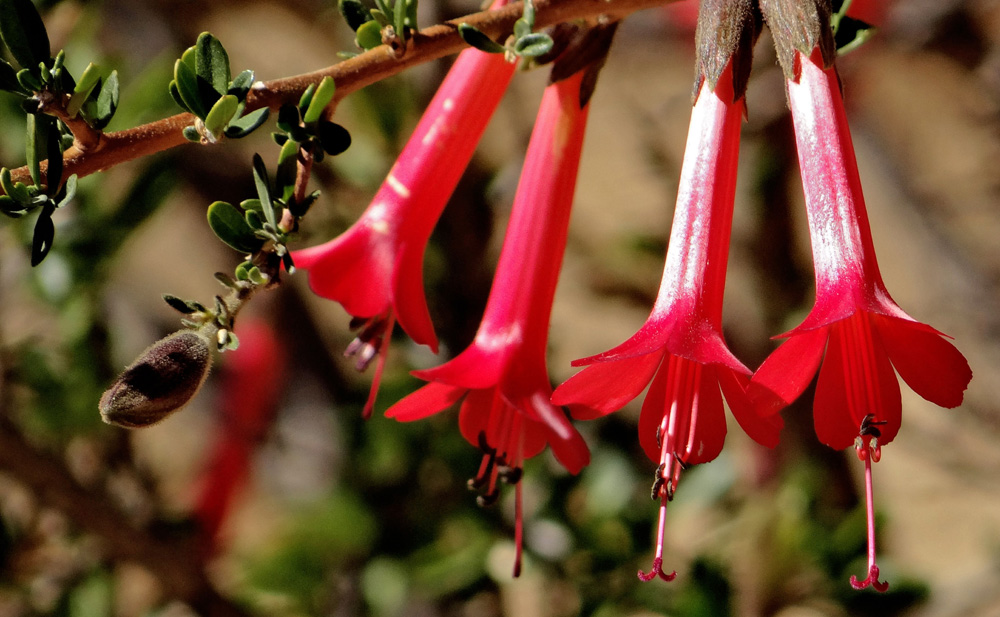
General Information:
Neea buxifolia is a stiff, twiggy, yet manageable and versatile shrub native to Puerto Rico. Commonly spelled “Nia,” the botanical name is “Neea.” It is a member of the Nyctaginaceae family, which includes the Bougainvillea, and grows to fifteen feet with a trunk circumference of five to six inches. The leaves are about one quarter inch long, narrow, and oblong with a rounded apex. The petioles are short and the twigs grow laterally. The tree is especially attractive during the growing season due to the deep red colour of its new shoots. The bark is gray and smooth. Neea bears small flowers in spring and summer followed by little, red mature fruit in summer.
Neea grows somewhat like Ilex vomitoria in that the new branches grow in all directions. The effect can be dense and undisciplined. While this pattern may be a challenge at first, with attention the close growth of the twigs creates a compact outline desirable in bonsai.
Lighting:
Neea should be grown in filtered sun.
Temperature:
Minimum temperature at which the plant will survive is 40 F degrees. (Per Jim Smith in Vero Beach, FL.)
Watering:
Adequate water to keep it from drying out.
Feeding:
Trees should be fertilized twice a month and trace elements, especially iron and calcium, given twice a year.
Pruning and wiring:
The tree has no particular natural form, unlike Juniperus procumbens, which almost dictates a semi cascade or cascade style. Therefore, the Neea may be styled in any way consistent with the growth pattern of the particular tree, although formal upright would be difficult to manage. Neea may be branch pruned throughout the year in tropical locations. Since the branches and twigs elongate so rapidly, frequent pinching and trimming are necessary. Wiring is also difficult due to profuse, erratic branch growth. Broom and umbrella styles are easy and shohin is a good choice.
Propagation:
Neea may be propagated by branch cuttings from March through June, by seed, or by air layering. Seed propagation is especially useful for shohin rock plantings.
Repotting:
While young, the tree needs annual repotting and may be severely root pruned. Older trees should be repotted every three to five years. In tropical locations repotting may be done any time of the year. The soil should be well draining.
Pests and diseases:
No information available.
Bibliography:
Neea Buxifolia: A Puerto Rican Bonsai Treasure” in the World Tropical Bonsai Forum, Winter 1991: 17-20.
Reprinted as “Neea Buxifolia” in Florida Bonsai, Vol 25, No. 1, pg 25-26.
Compiled by Thomas L. Zane
